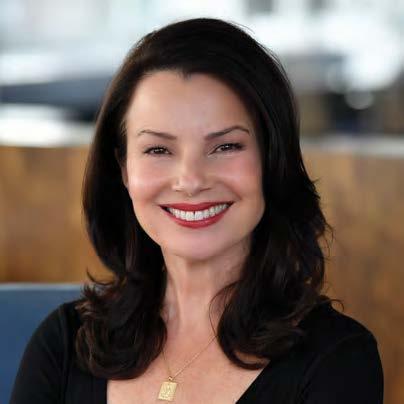














Leading

These are the local eateries where politicians call themselves regulars. PAGE

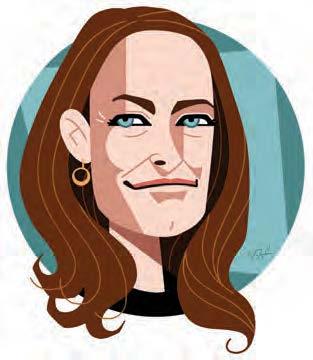

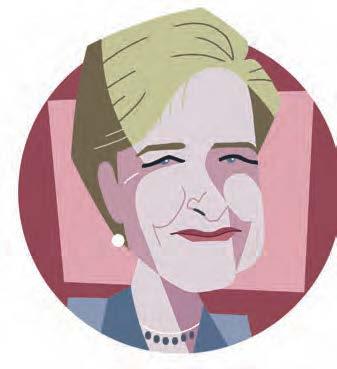
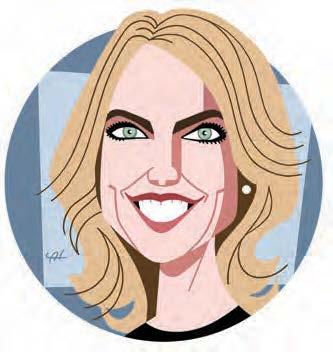

New York has become the rst U.S. city to embrace congestion pricing to reduce vehicle tra c and pollution in its busy urban core.
e Metropolitan Transportation Authority board on March 27 capped a years-long, often fraught review process by authorizing plans to charge drivers a $15 daytime toll to enter Manhattan below 60th Street, which is expected to generate billions of dollars to improve the region’s mass transit.
“New York has more tra c than any place in the United States,” said MTA Chair and Chief Executive Janno Lieber ahead of the vote. “And now we’re doing something about it.”
e approval sets up New York to join the likes of London, Stockholm and Milan in tolling drivers.
Under state law approved in 2019, congestion pricing is designed to collect $1 billion in annual tolls that the MTA will bond to $15 billion toward infrastructure upgrades for the city’s subway, buses and commuter rails. But congestion pricing faces the threat of several lawsuits. Garden State lawmakers furious with the fees are seeking to block the tolls in federal court. at lawsuit and other challenges led by New York detractors could delay or even derail the tolling program. MTA o cials have said they are con dent the tolls will move forward.
With the approved fees, drivers traveling into Manhattan through already-tolled crossings — the Holland, Lincoln, Brooklyn-Battery or
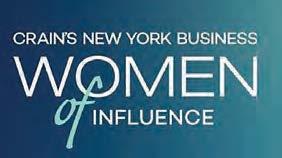
Crain’s will celebrate leading women who are poised to have a substantial in uence on New York City and their industries in the coming year. Along with 10 women chosen by Crain’s newsroom, this event will honor 25 nominees in three categories: Mentors, Rising Stars and WomenForward Workplaces. Winners in each category will be revealed LIVE at the lunch.

Queens-Midtown tunnels — will receive a $5 discount, reducing the fee to $10 during the day.
Cheaper tolls overnight
It will also be cheaper for motorists to drive at night. ere is a 75% discount between 9 p.m. and 5 a.m. on weekdays, and 9 p.m. Friday through 5 p.m. Sunday, dropping the toll to $3.75. During those overnight hours, however, the $5 tunnel credit won’t apply. e credit also does not apply to motorists crossing the George Washington Bridge, which is north of the congestion pricing zone.
Commercial trucks will be charged between $24 and $36, depending on their size, in a fee structure transit o cials say is designed to encourage commercial drivers to shift their operations to overnight when the fees are cheaper.
Crucially, the MTA says it reserves the right to raise the tolls up to 25% on days the city described as “gridlock alert days,” which tend to be days of bumper-to-bumper tra c during the holiday season and when the United Nations General Assembly is in session.
“We're at long, long, long, long last leading the nation,” said Meera Joshi, a newly appointed MTA board member and the city’s deputy mayor of operations, during the vote. “For city centers to survive and thrive, tra c congestion must be managed — it
dirties our air, adds hours to travel time, depletes the income of professional drivers, and drains our economy. Everyone loses. With today’s vote, we stem the tide.”
Joshi and Mayor Eric Adams had called on the MTA to exempt yellow cabs, but the industry will instead see steeply reduced fees
billion annually.
" e more exemptions that we grant, the more people who don't get exemptions feel that they were left out, that we were being unfair," said Carl Weisbrod, chairman of the Tra c Mobility Review Board, ahead of the vote. "And the fairest way to do it, we felt, was to provide as few exemptions as possible."
“The more exemptions that we grant, the more people who don’t get exemptions feel that they were left out, that we were being unfair.”
Carl Weisbrod, chairman of the Traf c Mobility Review Board
tacked on to trips. For cabbies, the MTA will add a $1.25 surcharge to the fares of yellow and green cabs, while a charge of $2.50 will be added to trips through rideshare services such as Uber and Lyft. ose fees will be passed on to passengers.
Much of the recent debate around congestion pricing has focused on groups jockeying for last-minute exemptions. The final tolls include very few exemptions, and that’s by design, the mobility board said; the more groups that are exempt from the tolls, the higher the base fee would be because the authority is bound by state law to raise $1
e congestion pricing plan has long included exemptions for city emergency vehicles. Drivers who earn less than $50,000 annually can apply for halfpriced daytime tolls. But the half-priced fees will kick in only after motorists take 10 trips into the congestion zone each month.
In recent days transit o cials said they had tweaked the tolls rst proposed in November by the mobility board, which was responsible for recommending an initial toll structure to the MTA board.
e MTA ultimately added a few more exemptions: Yellow school buses, privately operated commuter buses, including Greyhound, Mega Bus and the Hampton Jitney, and expanded exemptions for city vehicles on o cial business. e city’s Department of Citywide Administration Services says it now anticipates that roughly half of the 8,000 nonessential vehicles in the city’s eet of 30,000 vehicles won’t
need to pay congestion fees. at includes garbage trucks, street sweepers, water, sewer and street repair vehicles, parks forestry trucks and others. Additionally, buildings inspector, child services investigator and social service outreach team vehicles will be exempt, according to DCAS.
e Adams administration had publicly pushed for the broader exemptions for the municipal eet.
“Congestion pricing is here, and we are glad that this plan will be delivered for working-class New Yorkers,” said Liz Garcia, a spokesperson for the mayor’s o ce. "We have full con dence in our newest MTA appointees, Deputy Mayor for Operations Meera Joshi and City Planning Chair Dan Garodnick, who will help ensure that congestion pricing dollars improve underserved neighborhoods and enhance our transit system while simultaneously delivering on the promised environmental benets."
Juliette Michaelson, the MTA’s deputy chief of policy and external relations, emphasized during the March 27 vote that the expanded exemptions are designed for vehicles that are necessary to carry out city services, not for cars shepherding high-ranking o cials around Manhattan.
“We’re not talking about commissioners’ vehicles; we’re not talking about elected o cial vehicles,” said Michaelson. “ ose vehicles are speci cally and categorically not exempt.”
e tolls must get one last nod from federal regulators, which is expected to happen in the coming weeks.













MThe city restaurants where politicians call themselves regulars
ayor Eric Adams’ go-to New York restaurant is a Black-owned vegan spot where he orders curry chickpeas and candied yams. New York City Comptroller Brad Lander frequents a hot new Indian opening in Park Slope. And Manhattan Borough President Mark Levine is all-in on Harlem’s last old-style-rugelach bakery. at’s according to a new “District Dining Guide” from the New York City Hospitality Alliance, which surveyed dozens of city o cials on their go-to restaurant within their districts. “It’s not the best restaurant or their favorite restaurant, it's the go-to,” said Hospitality Alliance Executive Director Andrew Rigie. “Some may be really well known, but others may be low-key spots that don’t get a lot of press but are absolutely worth knowing about.”
From city council members to borough presidents, these are the New York restaurants where local politicians claim to be regulars:
Mayor Eric Adams: Uptown Veg
Comptroller Brad Lander: Masalawala & Sons
Brooklyn Borough President Antonio Reynoso: Shalom Japan
Manhattan Borough President Mark Levine: Lee Lee’s Baked Goods
Bronx Borough President Vanessa L. Gibson: Chocobar Cortés
Queens Borough President Donovan Richards: e Door
District 2 Council Member Carlina Rivera: Casa Adela
District 3 Council Member Erik Bottcher: Cafeteria
District 4 Council Member Keith Powers: Burger Joint
District 5 Council Member Julie Menin: Budapest Café
District 6 Council Member Gale Brewer: Gennaro Italian Restaurant
District 7 Council Member Shaun Abreu: Saiguette
Deputy Speaker and District 8 Council Member Diana Ayala: Tres Leche Café
District 12 Council Member Kevin Riley: Sangria Café
District 13 Council Member Kristy Marmorato: G & R Deli
District 15 Council Member Oswald Feliz: Antonio’s Trattoria
District 16 Council Member Althea Stevens: Black Bodega
District 17 Council Member Rafael Salamanca Jr.: El Porton
Majority Leader and District 18 Council Member Amanda Farías: Sabrosura
District 20 Council Member Sandra Ung: Nan Xiang Xiao Long Bao
District 21 Council Member Francisco Moya: Empanadas Café
District 22 Council Member Tiffany Cabán: Bench Flour
District 23 Council Member Linda Lee: Usha Foods

District 24 Council Member James F. Gennaro: Annam Brahma
District 25 Council Member Shekar Krishnan: Samudra
District 26 Council Member Julie Won: Dawa’s
District 27 Council Member Nantasha Williams: Nettie’s Restaurant
Speaker and District 28 Council Member Adrienne E. Adams: e Door
Majority Whip and District 31 Council Member Selvena N. Brooks-Powers: Jamaica Breeze
District 33 Council Member Lincoln Restler: Fin du monde
District 34 Council Member Jennifer Gutiérrez: Sazon Perez
District 35 Council Member Crystal Hudson: Sofreh
District 38 Council Member Alexa Avilés: Yafa Café
District 43 Council Member Susan Zhuang: Shaxian Snacks
District 45 Council Member Farah Louis: Bamboo Walk
District 46 Council Member Mercedes Narcisse: Trini Jam
District 47 Council Member Justin Brannan: Aleli
District 48 Council Member Inna Vernikov: Michael's
District 49 Council Member Kamillah M. Hanks: Seppe Pizza Bar
Minority Leader and District 51 Council Member Joe Borelli: Annadale Terrace
The billionaire developer’s six-bedroom duplex features an outdoor pool next to its primary suite
C. J. HughesJe Greene is looking to unload his home in a familiar building.
It’s one he developed.
e billionaire and occasional Democratic candidate has listed his duplex penthouse atop 62 Wooster St. in SoHo. e sixbedroom condo with exposed brick walls and an outdoor pool next to its primary suite is asking $35 million.
e move comes amid what appears to be a troubled time for the building, a seven-unit development that has not sold a single apartment since being approved for marketing a decade ago, though Greene’s exit will presumably not spell the end of his association with the site. He's also involved with a much bigger project in Hudson Square.
Spanning 6,900 square feet, the penthouse features a oating staircase, six and a half baths and a living room with a wall wide enough to accommodate nine windows. Also, each of the bedrooms o ers an en-suite bath.
A conversion located between Spring and Broome streets, 62 Wooster has listed four of its seven units over the past few years, though despite several discounts, none managed to nd takers and were ultimately pulled from the
market, public records show.
However, other apartments in the L-shaped building, which also uses the address 476 Broome, were set aside for Greene’s children and were intentionally never put up for sale, said BH Realty agent Colleen Breeckner, who is marketing the penthouse, which has never previously been available.
A full-time resident of Florida who has mostly built luxury homes there and in Southern California, Greene had never built anything in New York before snapping up the historic building at 62 Wooster in 2011 for $26 million after purchasing a defaulted mortgage note from a previous owner. When state o cials green-lighted the developer to begin selling condos at No. 62 in 2015, Greene anticipated a haul of $110 million, its original o ering plan shows.
But as the condo market softened and the pandemic began, the developer seems to have sharply curtailed expectations.
e most recent sell-out estimate, from 2022, was $87 million.
e price history of some units re ects the decline. Indeed, No. 5, a four-bedroom apartment, came on the market in 2017 at $18 million and by 2020 had adjusted its price downward to $15 million,

although there was a brief attempt to fetch $20 million in 2020 during a frenzied Covid-related boom.
Greene, who most recently ran for governor of Florida as a Democrat in 2018 (he also vied for a U.S. Senate seat in 2010), won’t be cutting real estate ties to the city if his penthouse sells.
Indeed, he is currently in sales mode at his other New York project, 100 Vandam St., a long-planned 25-story, 72-unit condo at Greenwich Street that juxtaposes a modern high-rise and a prewar former power plant.
e project, which started selling in 2022, anticipates a haul of

$413 million. But two years in, fewer than a dozen units have sold and closed, according to the data provider Marketproof. At the same time, several units in the tower are currently available as rentals, according to listings site StreetEasy. No. 100’s penthouse had been listed at $175,000 a month last summer, a seeming record-high price, though it seems to have leased for $150,000 in the end.
Whether Greene himself intends to relocate to 100 Vandam is unclear. Breeckner declined to discuss the developer’s plans. But
he doesn’t seem to have lived at 62 Wooster for a bit; the penthouse was rented last year for $75,000 a month.
Perhaps known best for development successes, Greene catapulted himself into a new prestige and wealth tier around the time of the Great Recession, when he bet that the housing market was due for a collapse. e timely wager reportedly nabbed him $800 million.
City
the Upper West Side, according to the city's O ce of Special Enforcement. e listings saw more than 550 bookings from more than 2,000 guests between 2019 and 2022, and Cartagena and Mega Home received more than $2 million in payments for them from Airbnb, the agency said.
The city had 22,247 short-term rentals in August, a month before the new rules took effect. That plummeted to 3,011 in January.
Mega Home and broker Katherine Cartagena had converted four
and 207 W. 75th St. between Amsterdam Avenue and Broadway on
Cartagena and Mega Home, which state records show is based on Long Island and lists her as its CEO, have taken down the illegal listings, and Cartagena will lose her real estate license if she advertises illegal short-term rentals again, according to the city.
“ is settlement highlights the importance of robust reporting requirements for booking platforms and short-term rental registration in combating illegal short-term rentals and the atten-
dant loss of housing,” O ce of Special Enforcement Executive Director Christian Klossner said in a statement.
Cartagena did not respond to a request for comment by press time.
A short-term rental is any place rented out for less than 30 days.
Under city law, for them to be legal, hosts must live in the same residence as their guests and have no more than two guests at a time.
Hosts also cannot rent out an entire apartment or home to a guest for less than 30 days.
Since September the city has required Airbnb hosts to register their apartments with the city in order to be paid by the company, a move Airbnb strongly opposed. e law was endorsed by Mayor Eric Adams and backed by New York's powerful real estate and hotel industries, and it has dramatically curtailed Airbnb's presence in the ve boroughs. e city had

|
22,247 short-term rentals in August, a month before the new rules took e ect, and this plummeted to 3,011 in January, according to the research rm AirDNA.
The regulations have helped boost the city’s hotel industry,
with average daily rates reaching $301.12 last year, the most expensive they have been, according to data from the commercial real estate firm CoStar. They are expected to rise even further this year.


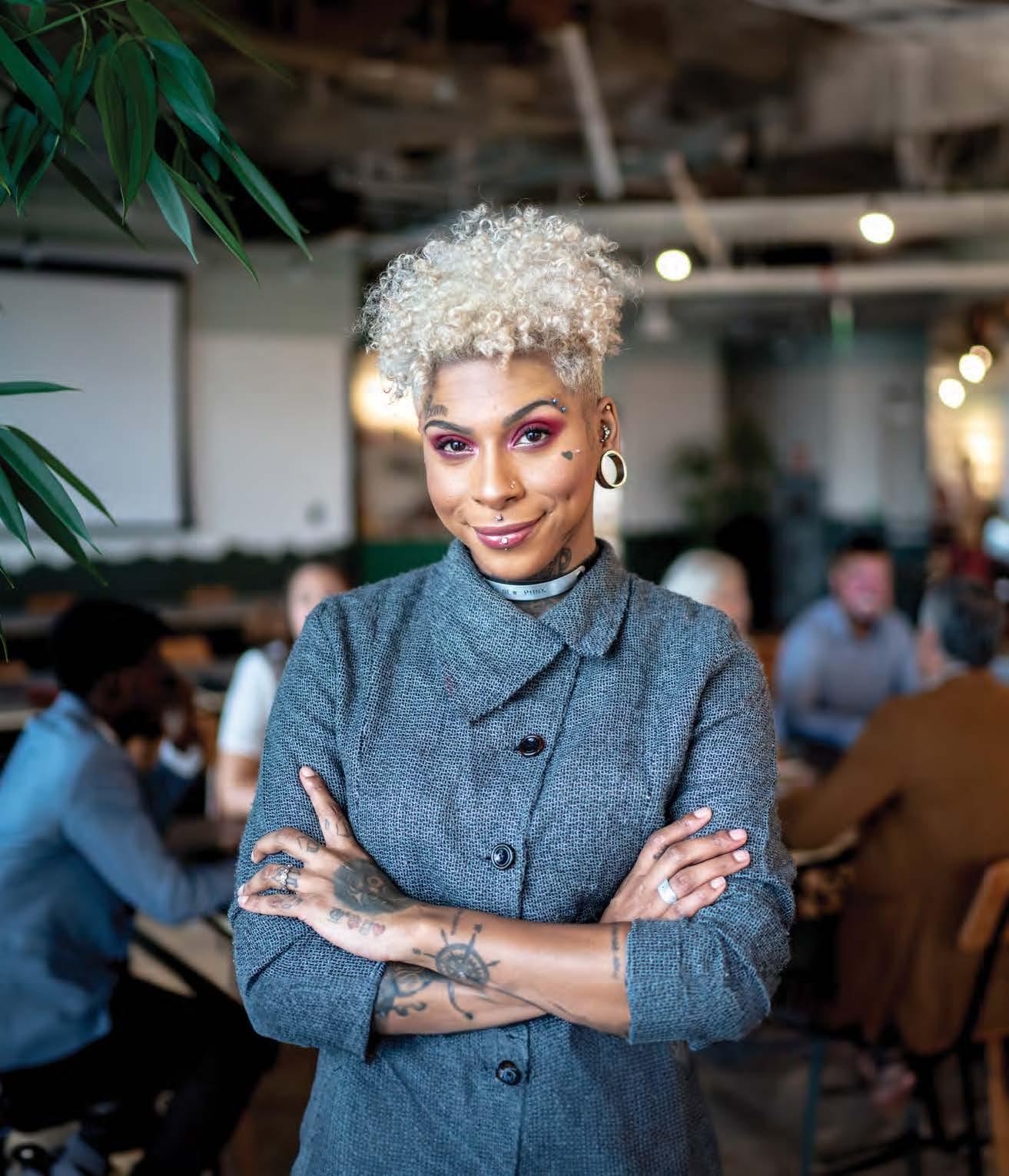


Nominate an LG BTQIA+ leader making a difference in their industry and community.
NOMINATE BY APR. 26
CrainsNe wYo rk.com/Not a bleNoms
I’ll start this column by laying my metaphorical cards on the table: I don’t like gambling. At all. I’ve written, critically, about the planned casino boom in New York. Casinos do not, in most cases, drive economic growth in the cities and towns where they’re built. Money goes in and doesn’t come out. A nearby restaurant or shopping mall or museum isn’t bene ting from the gambling dollars a casino hoovers up.
Andrew Cuomo, the disgraced former governor, believed casinos could be economic engines for struggling upstate communities. is, not surprisingly, hasn’t been the case. Now his successor, Kathy Hochul, is about to authorize three new downstate casinos with the same faulty premise in mind: ese new palaces will be great for Willets Point or Hudson Yards or Coney Island or wherever they end up.
free soda and lemonade o ered on the oor.
dages at the person you just lit on re.

Mobile sports betting on professional sports has been legal since 2022. Right now, the Democrat-run state legislature is debating ways to make it easier to gamble, from your smartphone, or many more scenarios. Point spreads, apparently, are for losers. State Sen. Joseph Addabbo, the chairman of the Racing, Gaming and Wagering committee, has a proposal in the budget that would allow residents to bet on coin tosses, tournament MVPs, and other prop and future bets. A New Yorker could soon bet on the length of the national anthem or the color of the Gatorade dumped on the winning Super Bowl coach.
Here’s an analogy they also won’t like: What if we legalized cocaine and heroin and started taxing it? ink of the cash that could be raised for public education! Granted, $2 billion over two years sounds impressive until you realize that in a single year, New York State spends more than $30 billion on public schools.
But I’ll be honest: e legalization of mobile sports betting in New York — and almost everywhere else — makes me nostalgic for the casino craze.
At least casinos are places. You have to drive to them or take a bus. You might go with your friends. You can eat dinner or catch a show. When I visit family in the Midwest, I enjoy trips to the casino. I don’t gamble, but I do like the
Addabbo, perhaps mobile sports betting’s biggest cheerleader in the state, recently boasted that legalization has brought in more than $2 billion to the state’s education fund in the last two years. His proposal would also set aside 1% of revenue or at least $6 million toward addiction services for problem gamblers.
Whenever gambling addictions are brought up, state lawmakers and the major sportsbooks, like FanDuel and DraftKings, always mention the services. It’s a bit like tossing alcohol swabs and ban-
e drug analogies work because gambling addictions function in the same way. Gambling activates the brain’s dopamine-powered reward system. Gambling, in particular, is associated with cognitive distortions. Casinos and sportsbooks make the most money on those who keep gambling and keep losing — those most addicted and deluded enough to believe that with one big win, they can make up for their losses.
Gambling addictions are exploding across America. A gambler can at least leave a casino. With a smartphone, there is no leaving, no ending, no walking away. e next bet is a tap away, 24/7, 365 days a year. Young men, in particular, are vulnerable to spiraling out.
An alcoholic or heroin addict is visibly sick. A smartphone gambling addiction, though, can hide

in plain sight. e problem gambler can be on a phone, betting and betting, until their savings are wiped out. It’s the technology that makes the addiction so vicious.
Marijuana isn’t as addictive or destructive as gambling. Alcohol might be, but we as a society have made peace with its presence and recognized, during the Prohibition era, that outlawing it only fueled organized crime.
But there’s no real good, serious argument for legalizing mobile sports betting. New York and more than 30 other states decided, after a 2018 Supreme Court ruling, to jump at the cash, and sports leagues have enthusiastically promoted gambling since.
For a few extra education dollars — less than 1/30th, annually, of what the state spends on public schools — New York is seeding a new generation of gambling addicts. A vice now blooms that was far less widespread in the 2010s.
What’s the answer? Banning mobile sports betting and accepting casinos, perhaps turning them into hubs for gambling on the NFL or MLB. Make gamblers at least travel somewhere to place sports bets. Remove the dopamine hits living in their pockets.
Otherwise, all of this is going to get much, much worse.
Ross Barkan is a journalist and author in New York City.
ey’re on the right track.
More Long Islanders are ocking to Midtown East now than have in the past several years, thanks in part to the opening of the long-awaited transit connector known as East Side Access, linking the Long Island Rail Road with the new Grand Central Madison station.
e president of the Grand Central Partnership recently touted a spike in pedestrian tra c in the dis-
had a signi cant impact on people with Long Island ZIP codes being in our district,” Alfred Cerullo told Crain’s on March 20.
Last year the Metropolitan Transportation Authority debuted Grand Central Madison, with full LIRR service beginning Feb. 27, 2023. Transit o cials said at the time that the project, which ballooned in cost to $11.1 billion, would divert an estimated 45% of LIRR commuters from the overcrowded Penn Station to the new Grand Central stop.
“[Grand Central Madison] has had a signi cant impact on people with Long Island ZIP codes being in our district.”
Alfred Cerullo, Grand Central Partnership
trict, which spans 70 blocks between East 35th and East 54th streets and from Second to Fifth avenues — a notable chunk of which comes from those who hail from Nassau and Su olk counties, he said.
“[Grand Central Madison] has
And in the business improvement district surrounding Grand Central Terminal, at least, that reroute appears to be having a massive transformation. Pedestrians with ZIP codes from Long Island visited or roamed the area a whopping 115.5% more than they did in 2022 and 35.7% more than they did last year, according to data from Placer.ai, which analyzes mobile phone locations, and compiled by the Grand Central Partnership, which compared roughly the same six weeks between the end of January and the beginning of March in
2022, 2023 and 2024. In 2022, for example, 431,945 people with Long Island ZIP codes visited the district while 686,092 did in 2023, and 930,848 in 2024, according to data shared with Crain’s Midtown has been notoriously slow to recover from the pandemic, so the extra foot tra c is welcome, said Cerullo, whose district includes 76 million square feet of commercial, residential and retail building space. People on foot are the prime customer base for nearly every single category of retail, whether it’s restaurants or clothing stores, he said.
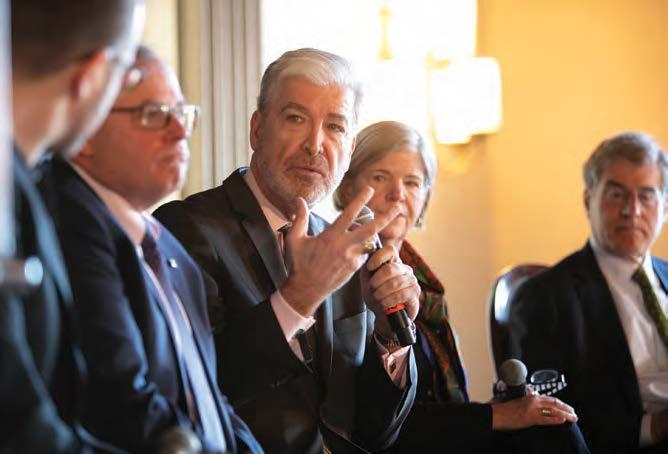
And at a Crain’s Power Breakfast March 19 in Midtown during a discussion with Editor-in-Chief Cory Schouten and other business improvement district leaders, Cerullo pointed to two other trends that have been shifting the character of the otherwise nomadic neighborhood. Pedestrian counts at a pair of corners — one at Fifth Avenue and 38th Street and the other at Lexington Ave-
nue and East 42nd Street — are also exceeding levels from 2019, at 119% and 104%, respectively. But what makes it even more noteworthy is that pedestrian counts on Saturdays and Sundays have actually been outperforming some weekdays, he said, calling the unexpected activity a “completely new phenomenon.”
It’s not clear what exactly is driving the increased tra c on
those days, or at those locations, Cerullo said, but the new Grand Central Madison nearby and a recent revival in tourism bene ting the Empire State Building just blocks away likely aren’t hurting. “It helps to change the dynamic of the neighborhood, from the typical Monday through Friday 9-to-5 to a more seven-days-aweek neighborhood for people and families,” he said.
Monte ore Medical Center seeks to build a 21-bed intensive care unit at its Henry and Lucy Moses Division hospital campus in the Norwood neighborhood of the Bronx. e project would cost about $15 million, according to a certi cate of need led with the state Department of Health last month.
Peter Semczuk, the senior vice president of the health system and executive director of its Moses and Wake eld campuses, told Crain’s Monte ore would build the additional ICU space by gut-renovating an existing medical-surgical unit on the seventh oor of the hospital’s Foreman Pavilion.
e hospital is performing more transplants and surgical intervention procedures, Semczuk said, as the need for intense care is growing in the Bronx and more patients come into the hospital sicker and with more complex illnesses. On top of this, the hospital is elding a growing number of transfers from other facilities around the city, he added. According to the
hospital its transfer center has seen a 30% increase in transfers since 2019.
“We've seen dramatic, signicant, substantive growth in all of those areas,” Semczuk said, creating a need for more intensive care space.
e new space would allow Moses to care for several hundred more ICU patients annually. Semczuk added that patients with fewer needs could also be treated in the ICU beds, if necessary, and there is space available at other Monte ore hospitals to take care of medical-surgical patients that would have gone to the Moses unit. According to the health equity assessment that accompanies Monte ore’s state ling, the project would not eliminate services or care or reduce the hospital’s number of certi ed beds by 10% or more.
If the state approves the project, Semczuk expects construction to begin in July. Monte ore operates 10 hospitals around the Bronx and the Hudson Valley.
Gov. Kathy Hochul allocated $102 million to new care models to improve outpatient care for people with complex mental illnesses, including those recently discharged from psychiatric hospitals.
e funding, which is administered by the O ce of Mental Health, includes $92 million for Critical Time Intervention teams — a rst-time program in New York state.
Justin Mason, a spokesman for the O ce of Mental Health, said that the teams aim to reduce hospital admissions and visits to emergency rooms or Comprehensive Psychiatric Emergency Programs, which are emergency departments that speci cally treat people with mental health concerns. e teams are supposed to shorten the time between hospital discharges and outpatient visits, and are a key part of regulations to create a standard for behavioral health hospitalizations and discharges proposed by health o cials in January.
Roughly $31 million of the total investment will develop new care
teams downstate and $42 million will go towards upstate programs, the governor’s o ce said. e state also allocated $19 million to build 11 teams in rural areas statewide.
In addition to the Critical Time Intervention teams, Hochul also announced $10 million to expand care teams that serve homeless youth in New York City. e funding will support development of new Safe Options Support teams to help homeless teens and adolescents nd housing and stable care. e teams, which launched in 2022, have moved 390 homeless individuals o the streets so far, the governor’s o ce said. e launch of new mental health teams are part of the governor’s $1 billion mental health plan, which is committed to launching 50 Critical Time Intervention teams statewide. e re-
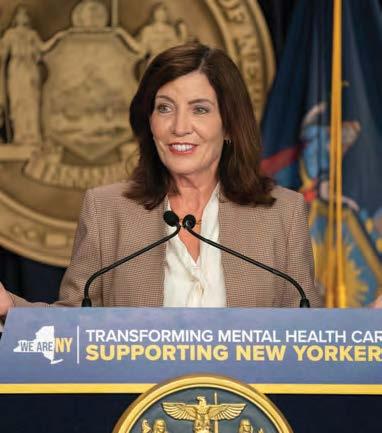
cent investment will fund 26 such teams.
Earlier this year, the O ce of Mental Health released $55 billion to build nine of the new teams in New York City and Long Island. Mason said that the state is reviewing applicants and plans to award contracts in the coming weeks.

Request for Proposals -
Issue date April 2, submissions due June 28. 25,000 sq. ft/32 units in the heart of New York City
The Metropolitan Transportation Authority is soliciting proposals for a Retail Master Lease, seeking a strategic retail partner to develop and operate a successful retail program in Grand Central Madison, providing a curated, one-of-a-kind retail experience for everyday customers catching the new Long Island Rail Road service into Grand Central.

grandcentralterminal.com/ grand-central-madison
212-984-6544
212-984-6698

New York City last week became the rst U.S. city to approve congestion pricing tolls, an ambitious program to fund mass transit upgrades and relieve gridlock on city streets.
Similar programs in London, Stockholm and Milan have helped improve transit, reduce pollution and improve the overall quality of life. ere’s good reason to expect similar outcomes here.
e MTA’s approval of $15 daytime tolls to enter Manhattan below 60th Street starting in mid-June caps a grueling, yearslong e ort and proves that New York can still tackle big challenges when elected ofcials and civic leaders step up and work together with key stakeholders, including in the business community. Now the focus must turn toward execution — of a simple, fair tolling system with minimal exemptions, and responsible stewardship of the resulting funds to deliver a world-class transit system.
Of course, sour grapes remain among some New Yorkers who cling tightly to their cars and suburban mindsets — and elected o cials in New Jersey who could

use a refresher course on jurisdiction. e handful of pending lawsuits should be quickly dispatched: It’s time for the naysayers to move on and accept a tolling formula that’s thoughtful and fair.


e program o ers few exemptions, save for emergency vehicles, school buses,
commuter buses and city vehicles necessary for carrying out services (not carting around high-ranking government ocials). But there’s a 75% discount for latenight trips to encourage o -peak travel, signi cant discounts for Uber cars and yellow cabs, and exemptions for people
Since Gov. Kathy Hochul appointed me as New York State Health Commissioner one year ago, leaders of struggling hospitals and nursing homes from Far Rockaway, the North Country, and Bu alo, have told me the same story. ey have remarkable workers, yet costs of hiring and retaining quali ed sta are unsustainable. No matter the location, the workforce options are limited.
e state can solve this complex problem with a simple solution — expand health care workers’ scope of practice. is small measure will allow health care professionals such as medical assistants, nurses and nurse practitioners, and dental hygienists to undertake functions they are trained to perform but are not included in the scope of their certi cation in New York State.
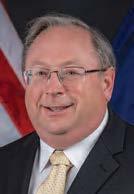
a medical assistant to administer a vaccine although during the pandemic almost any medical professional, including medical assistants, could give you a COVID shot. Medical assistants should be able to do this even when we are not in a national emergency.
Most states also allow certi ed medication aides to administer basic medications, but not New York. How does this serve timely patient care when nursing homes face sta ng challenges?
not joined the compact.
During the pandemic, New York allowed hospitals and nursing homes to ll vacancies with nurses licensed in other states with no impact on patient safety. We should make this arrangement permanent by joining the Nurse Licensure Compact.
Many of New York’s scope-of-practice laws are generally more restrictive than other states, and I have yet to see evidence that it serves patients better than other states. In fact, I am concerned our standards make it more di cult for patients to receive the care that they need and deserve in New York State.
We are the only state that does not allow
New York allows nurse practitioners with su cient training to practice independently in certain settings, but not physician assistants. New York should allow physician assistants to practice independently — this change will greatly contribute to addressing healthcare workforce challenges in hospitals and will help increase timely access to primary care providers.
Forty-one states have entered an agreement, called the Nurse Licensure Compact, that allows registered nurses from other states to work in their states. e Trust for America’s Health Ready or Not report recently highlighted New York as de cient in this public health emergency preparedness metric, since we have still
with disabilities. Low-income drivers can apply for half-priced daytime tolls.
e MTA should monitor tra c data to identify and make adjustments that are justi ed as tolling rolls out but should stand rm on no carve-outs for elected ofcials, political donors or bureaucrats who could absolutely take transit with the rest of us. e program can ill a ord another patronage merry-go-round like the one with parking placards. And once tolling proceeds roll in, the MTA must deploy the funds wisely on upgrades that make it easier, safer and more pleasant to use public transit in New York City.
“We’re at long, long, long, long last leading the nation,” MTA board member and deputy mayor Meera Joshi said during last week’s vote. “For city centers to survive and thrive, tra c congestion must be managed — it dirties our air, adds hours to travel time, depletes the income of professional drivers, and drains our economy.”
Now the real work begins.

Forty states have joined the Interstate Physician Licensure Compact, yet not New York. More and more hospitals are having a very hard time recruiting physicians, like anesthesiologists, radiologists, and emergency medicine physicians. Not having physicians in your community makes it more di cult for New Yorkers to access care.
Many states allow a dental hygienist to practice independently in certain settings. ere are identi ed shortages in dental care in many rural areas. Allowing dental hygienists to provide additional services will alleviate these shortages.
Hospitals and nursing homes are ask-
ing for higher reimbursement, and New York has made significant investments in funding increases. However, rules requiring advanced practitioners do tasks that others can safely perform are a major cost driver that has not been addressed. These ongoing costs are unsustainable.
I urge the Legislature to adopt these changes, as Governor Hochul has proposed as part of her executive budget. Enacting these solutions could help our struggling health care facilities while not impacting the quality of care New Yorkers have come to expect.
Among all the issues our country faces right now, a major threat to New York’s small businesses and manufacturers is not getting the attention it deserves. e IRS and proponents in Congress have set their sights on business partnerships as a new target in their never-ending quest for tax dollars.
As a business leader, I've seen how vital these partnerships are for fostering innovation, supporting jobs and driving growth in our state’s business community. However, recent tax proposals have introduced signi cant concerns around what the future could hold for successful businesses.
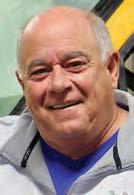
ese proposals aim to impose new rules that would not only increase the burden on small partnerships but also disincentivize critical investments that stimulate New York’s economy. It's essential to understand that these changes strike at the heart of many communities, threatening local farms, neighborhood retailers and even manufacturers who have dedicated decades to building businesses that serve our communities and employ millions of Americans.
During his campaign, President Joe Biden committed to not raising taxes on Americans making under $400,000. Despite this promise to voters, the plan to go
LETTER TO THE EDITORafter business partnerships includes changes to Subchapter K of the IRS code, which would, in fact, threaten those making under $400,000. is contradiction is not just a breach of trust — it’s a potential blow to the core of our economic system, where small businesses and manufacturers would nd themselves under increasingly di cult circumstances.
e justi cation for these sweeping reforms rests on shaky ground. Danny Werfel, commissioner of the IRS, made his misguided case in a Bloomberg Law op-ed, explaining that partnerships should be subject to more government rules, requirements and audits to be held accountable for “what they owe.” However, research from the Cato Institute shows that the tax gap — the difference between taxes owed and taxes collected — has actually been stable relative to the size of the economy and is, in fact, lower than it was decades ago.
e reality is that partnerships, including those in the manufacturing sector, are often the vehicles through which innovation is funded and new projects are launched. ese projects range from sustainable agriculture to renewable energy initiatives. e proposed tax changes would undermine the exibility necessary

for structuring partnerships that make such investments feasible, potentially stiing innovation and reducing overall investment in vital sectors.
In 2019, partnerships employed more than 16 million Americans. ese jobs and the compensation they provide are crucial not just for the individuals and families directly involved but for the health of our nation’s economy. What’s more, the complexity and compliance costs associated with these changes would disproportionately a ect small businesses and manufacturers, who are less equipped to navigate the labyrinth of new tax regulations.
As we stand at this crossroads, it's im-
perative that our state’s leaders like congresswoman Nicole Malliotakis and Senate Majority Leader Charles Schumer push back against IRS overreach and protect against the broader implications of the proposed IRS expansion and its impact on business partnerships. e proposed tax changes risk undermining the very foundation of our economic prosperity — all in the pursuit of revenue to fuel Washington’s ongoing spending spree.
It's crucial that we preserve the exibility and incentives that allow business partnerships to thrive and contribute to our economy. As we navigate the challenges ahead, we cannot forget the importance of supporting policies that foster growth, innovation and stability for businesses big and small. Our future prosperity depends on it.
capital subsidies should be included in the city’s budget to generate more affordable housing
AS AN URBAN PLANNER and longtime housing advocate prior to entering politics, I'm happy to see Crain’s editorial page champion the need for a ordable housing ["Editorial: With a ordable housing, comptroller should do less talking, take more action," March 18]. As I have said many times, there is no greater priority facing our city than making sure that people of all walks of life can still a ord to live in it. And as the editorial page recently noted, talking about a ordable housing is one thing, and acting on it is another. To that end, I welcome this opportunity to detail the historic, robust actions the comptroller’s o ce is taking to tackle this crisis.
During my tenure, our o ce executed the city's rst-ever social bond issuances exclusively for a ordable housing. e two social bonds we issued generated $1.1 billion to nance 7,500 units of deeply a ordable housing for families, seniors and those in need of supportive housing in New York City. (For this innovative work, we were recognized with a Social Bond of the Year award.)
Crain’s encourages the city’s ve pension funds to invest more in a ordable housing. Within prudent limits, I agree. Along with the funds’ other trustees, I am committed to improving and expanding economically targeted investments (ETIs), a program designed to address
market ine ciencies by providing capital to underserved communities in New York.
To date, the ve pension systems have invested approximately $637 million in 29,099 apartments in the city, with 17 real estate fund managers. Of that, 16,420 units are workforce housing totaling approximately $253 million, in addition to other a ordable housing programs we invest in, such as the Public Private Apartment Rehabilitation program, the AFL-CIO Housing Investment Trust, and the Community Preservation Corporation Construction Loan Facility, among others. We are proud to have increased those investments during this term. (It is true that the percentage these investments represent of our overall portfolio has not increased; but that is primarily because our overall portfolio has grown 41% over the past six years — hardly something to complain about).
Meanwhile, since I entered the comptroller’s o ce, we have been in the process of reviewing and modernizing our ETI and real estate programs — and will be making major announcements for turning more pension fund investments into a ordable housing in the weeks to come.
However, as the Crain’s editorial board knows, pension funds cannot be invested as concessionary capital; they are invested to generate the returns needed to pay for retirement security for the teachers,
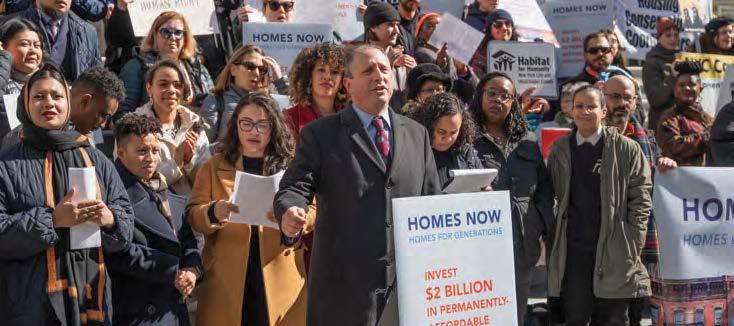
re ghters and other workers who serve our city. is means even through the ETI program, they cannot be invested as subsidy to make housing more a ordable for those who cannot a ord market rates. Every investment decision the trustees make comes as a result of a thorough due-diligence process that assesses the risk-adjusted investment rationale of the potential investment.
I am therefore calling for the mayor to include additional capital subsidies in the city’s budget this year, as part of the “Homes Now, Homes for Generations” campaign, to produce additional a ordable housing by covering the di erence
between what housing costs and what people can a ord to pay. I hope Crain’s will join me in supporting this campaign, as the Daily News editorial board recently did. is is an “all-hands-on-deck” moment for housing that requires creative solutions and investments from the city, the state, the private sector and, yes, the pension funds. We’re proud of the historic work we’ve done to promote a ordable housing in New York. It has long been — and most certainly remains — a top focus of our o ce … and of mine.
Brad Lander is the New York City comptroller.
To
contact Debora Stein at 917.226.5470 / dstein@crain.com
Project Management Advisors, Inc.
The Forum Group
Barclay Damon LLP

Project Management Advisors, Inc., which provides real estate owner’s representative services to help clients solve challenges, minimize risk and maximize outcomes, has promoted Jerry Maffia to New York Vice President and General Manager. With 40+ years of experience as an architect, owner’s rep, and construction manager to highly technical projects, Maffia is primarily focused on the growth of the New York and East Coast markets, as well as multifamily and hospitality sector projects.
TD Bank

TD Bank has tapped Craig Ratigan to serve as the Regional Vice President for the Manhattan II Region. In this role, Ratigan will leverage his deep experience and expertise to drive commercial bank growth, supporting the financial goals of clients across a diverse set of industries throughout Manhattan. Ratigan has 20 years’ experience in banking, most recently serving as TD Bank’s Senior Relationship Manager in Queens. Ratigan holds a bachelor’s in finance and an MBA from St. John’s University.

Amida Care

Amida Care, New York’s largest Medicaid Special Needs Health Plan specializing in providing comprehensive health coverage and coordinated care to people affected by HIV, is excited to announce Tamara May as their new Chief Operating Officer. May has extensive experience in health care operations, New York Medicaid, and the managed care sector. Her expertise in strategic leadership and community engagement highlights her deep commitment to enhancing member health outcomes.

The Forum Group is proud to announce James J. Minogue Jr. has joined as the Chief Operating Officer. As COO, Jim will develop new partnerships, grow existing relationships, and improve operations. He will focus on performance management and enhance efficiency and profitability. The Forum Group has eight divisions: A & F, IT, Compliance, HR, Legal, Marketing, Admin, and Healthcare. The Forum Group excels in contingency and retained search as well as temporary staffing across diverse industries.
Belkin Burden Goldman LLP
Belkin Burden Goldman LLP, a real estate law firm headquartered in NYC, is proud to welcome attorneys Alex B. Pia and Michael Nesheiwat to its Litigation Department.


Celine Dorsainvil, associate, has joined Barclay Damon’s Data Security & Technology and Trademarks, Copyrights & Licensing Practice Areas. Dorsainvil focuses her practice on protecting, transferring, and commercializing clients’ IP. She negotiates and drafts IP and technology-focused commercial agreements and monitors global data privacy and content moderation bills to identify compliance concerns and develop impact litigation strategies. Previously, she was an associate at Hogan Lovells.


Mr. Pia’s practice is centered on real estate litigation, construction, and intricate landlordtenant disputes. He serves a wide array of clients, including developers, property owners, management companies, brokers, condo and co-op boards, and commercial tenants.
Mr. Nesheiwat focuses on complex real estate litigation, particularly in residential and commercial landlord-tenant disputes, as well as in general business litigation and contract claims. Their addition is poised to increase the depth of BBG’s already experienced real estate litigation team. Pia

Maverick Public Relations

Bree DeVita has been named VP of Media & Influencer Relations at Maverick Public Relations and opened a New York City office for the agency, which specializes in sustainable technology, clean energy, biotech, agribusiness and cannabis. The expansion supports current media partnerships while implementing future planned initiatives. Her responsibilities include fostering journalist relationships, engaging influencers, and representing MPR at some of the world’s most influential events.


The year 2024 feels like a moment when New York City is taking a deep breath and asking, so what’s next? What do we want for this great city now that we’ve put behind us a pandemic that shook and realigned the world?
The cast of 11 women chosen by Crain’s newsroom and pro led in these pages are crafting the answers. They oversee enormous organizations like the FDNY and NYSE, channel the needs of business through City Hall and the Partnership for New York City, and shape policy on crucial issues. Many questions of fairness, legality, health and shelter are in their hands.
In this issue, Crain’s is also recognizing women and organizations who were nominated as Mentors, Rising Stars and Women-Forward Workplaces. Mentors have successfully lifted up many other women in their careers and the community. Rising Stars are emerging leaders who have promoted programs advancing women. Women-Forward Workplaces are where women have a voice in planning and operations, and these employers have policies in place that help women grow.
Please join us in congratulating this year’s honorees.
—Anne Michaud, assistant managing editor

Last November, when Fran Drescher sat across from the CEOs of a few of Hollywood’s major production companies, she was there to negotiate for the union’s most ambitious package ever as president of SAG-AFTRA, the Screen Actors Guild-American Federation of Television and Radio Artists.
ousands of members — actors, announcers, disc jockeys, newswriters, dancers and more — had been marching on picket lines in New York and Los Angeles for more than 115 days, in the biggest dual strike the industry had seen since the 1960s (the Writers Guild of America was on strike at the time). ey were ghting threats union leaders called existential.
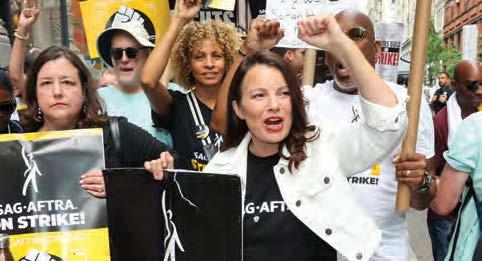
METHODOLOGY: The honorees did not pay to be included. Crain’s newsroom selected the 11 most influential women, and other honorees were drawn from submitted nominations. Their profiles are based on those submitted materials. This list is not comprehensive. It includes only executives and organizations for whom nominations were submitted and accepted after an editorial review. To qualify for this list, honorees had to work within the New York City metro area (the five boroughs of the city or Westchester, Rockland, Nassau and Bergen counties) and had to have demonstrated the ability or power to effect change in their role, in their area of practice or as an organization.

REACH: 160,000 members of SAG-AFTRA.
Drescher, a multi-hyphenate actor-writer-produceradvocate, rst rose to fame playing e Nanny for six seasons on television. At the negotiating table, she made the studio executives understand that times had changed, and she wouldn’t stop short of her goal to reach a deal that would protect all of her members.
WHAT’S NEXT: I tell this to my union members: ‘We have to build on this, leverage this and not be a one-hit wonder.’
“ ey thought it was going to be same old, same old,” Drescher told Crain’s. “We were not going to go in and just ask for incremental improvements. Forget about it. is was the seminal negotiation and there’s no ifs, ands, or buts about it.”
To emphasize her point, Drescher had walked the Flatiron District picket line the previous August and had addressed the New York City Council.
“As a kid back in Flushing, Queens, I always dreamt of becoming a professional actor,” she said. “But I never imagined that show business, which was so romanticized in the old movies of the ’30s and ’40s, would in 2023 become a soulless business of greed and disrespect for the performing artist.”
She and the negotiation team spent months gathering extensive input from union members in plenary sessions to identify pain points and key demands they would want to include in the contract. Protections from tech advancements like the use of AI and streaming and the widening gaps in wages exacerbated by the pandemic were at the top of the list of concerns for many of the union’s 160,000 members.
“We were coming in with one of the most ambitious packages we had ever put together,” said Linda Powell, SAG-AFTRA’s executive vice president, who was on the negotiating committee alongside Drescher. “ e energy that Fran brought into the room — she came in ready to say, ‘Anything we want to ask for, let’s ask for and not negotiate against ourselves.’ And it didn’t take much to take that ball and run with it, with her leadership.”
It wasn’t just Drescher’s experience as an actor, writer and producer that instilled in her the traits of an e ective leader. Her journey as a sexual assault and uterine cancer survivor also strengthened her resolve as she faced o against executives from television and movie production, studios and streaming platforms to secure a deal.
“ is is an extension of that and everything that I’ve ever accomplished in my life,” she said. “All of that has helped me be the person that I am, all come together, to be able to stand up to these people without fear.”
After 118 days of striking and intense negotiations, SAG-AFTRA and the Alliance of Motion Picture and Television Producers reached an agreement. e nal contract boasts wage increases, higher contributions to retirement and health funds, the introduction of an annual $40 million residual bonus for actors on streaming shows, protections against the use of AI, and adjustments for self-tape auditions, among other wins.
“No one leaves this planet unscathed,” Drescher re ected. “I turned my pain into purpose. It’s what we do with it, how we grow with it, and what becomes of us as a result [that] is the most important thing.”

Crain’s newsroom chose the following women who are leading by example and promoting ongoing change as honorees for the second annual Women of In uence awards.
Illustrations
by Ashley Holt
WHAT’S NEXT:
GOVERNOR SINCE the sudden resignation of her boss in 2021, Kathy Hochul has addressed a broad range of issues of concern to New Yorkers. Asked by Crain’s which were most consequential, she pointed to having strengthened the state’s “red ag” law, which prevents individuals who may be a threat from purchasing or owning rearms. Her o ce also pointed to a $35 million fund to support abortion providers. She called those actions “some of the most consequential in the nation.”
In her State of the State address in January, the governor also touted a roster of accomplishments, from investments in housing, child care assistance and mental health services to a minimum-wage increase and double-digit declines in shootings and murder. She also celebrated a decision by Micron to build a plant just north of Syracuse, which is a win for her plan to establish New York as a global hub for semiconductor manufacturing.
“$100 billion and nearly 50,000 jobs are coming to Clay, N.Y.,” the governor wrote in an email to Crain’s, noting that she had personally pitched Micron’s CEO.
e governor has also made her in uence felt by siding with the state’s business community on numerous bills supported by Democrats, which she has vetoed.
Hochul faces challenges that will test her in uence, from population loss in the state to budget gaps to the crime rate. e migrant in ux remains a drain on state and city resources. Speaking on the television program e View, the governor said she would appreciate federal money to handle the migrant costs and “a legal path we can control.”
She also will have to contend with controversies over such measures as congestion pricing in the city, which is raising opposition in advance of its anticipated debut in June. Another issue on the governor’s mind is a new law that will ban natural gas stoves and heating systems in new buildings beginning in 2026.
Undaunted, Hochul defends the measures, calling congestion pricing, in part, a solution to a “public safety problem.”
Attorney general, state of New York
REACH: More than 1,800 employees
WHAT’S NEXT:
Holding nursing homes accountable, safeguarding children and ensuring they’re safe online, and protecting workers’ rights
IN RECENT MONTHS, New York Attorney General Letitia James has scored some long-sought victories, reaping wins against former President Donald Trump for civil fraud and against the former president of the National Ri e Association, Wayne LaPierre, for nancial mismanagement and corruption. On top of that, she snared a $328 million payout for Uber and Lyft drivers for withheld wages. First elected in 2018, James regularly chal lenges the powerful in politics and business. Her wins have bolstered the co ers of the state, munic ipalities and others with recoveries, settlements and penalties that in 2022 totaled $2.6 billion.

Among her current targets are the NCAA for allegedly restraining college athletes from marketing their labor and controlling their educations; PepsiCo, which the AG says is harming the public and environment with single-use plastic packaging; the beef producer JBS USA Food Company, which James has charged with misleading consumers about its environmental impact; and Citibank, accused of failing to protect and reimburse victims of fraud.
Such prosecutions have raised her pro le — and also earned her vociferous critics, including a group of reghters who recently booed her and chanted “Trump!” at a ceremony where she spoke.
An erstwhile candidate for governor in 2021, she suspended her campaign after a month, saying she had more work to do as attorney general. Still, re-elected as attorney general in 2022, she has made sure to let the people of New York know what she’s doing on their behalf. Her o ce posts on social media site X, formerly Twitter, about the amount of daily interest that is accruing on the $454 million judgment against Trump, underscoring her successful prosecution.
A steady stream of press releases from James’ o ce catalogs her victories, her latest undertakings and her views on current and often politically sensitive topics. For example, she condemned a recent executive order by Nassau County Executive Bruce Blakeman prohibiting transgender athletes from competing at county-run athletic facilities.
—Judith MessinaDeputy mayor for housing, economic development and workforce, New York City
REACH: 500,000 affordable homes in the next decade
WHAT’S NEXT: Preserve and improve the New York City Housing Authority, move the homeless into stable housing, and create 500,000 homes and 30,000 apprenticeships for New Yorkers
MARIA TORRES-SPRINGER has long experience in New York City government, having served as commissioner of Small Business Services, CEO of the Economic Development Corp., and commissioner of Housing Preservation and Development — roles in which, among other accomplishments, she launched a new citywide ferry service and put together nancing for 60,000 a ordable homes.
Since 2022, after a stint at the Ford Founda tion, Torres-Springer has been back at City Hall as deputy mayor for Housing, Economic Develop ment and Workforce. An architect of the mayor’s Get Stu Built and City of Yes programs to facilitate housing construction and amend restrictive zoning requirements, she has her work cut out for her. Among her mandates: Preserve and improve the New York City Housing Authority, move the homeless into stable housing, and create 500,000 new homes for New Yorkers over the next decade.
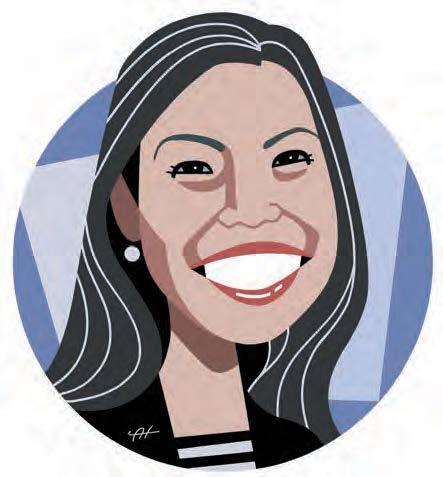
“ e moonshot goal of 500,000 new homes is so vital to the future of this city and our ability not just to remain competitive but be the type of beacon that attracts anyone in the world,” Torres-Springer said.
In December, the city broke ground at Willets Point in Queens for the rst phase of that moonshot, a project that will ultimately include 2,500 a ordable homes, a public school, retail space, a 250-room hotel and the city’s rst professional soccer stadium.
Noting that the Willets Point plan has spanned three mayoral administrations, Torres-Springer called it a lesson in persistence.
“More importantly,” she said, “it showed this work is not a sprint or a marathon; it’s a relay.”
When it comes to workforce and economic development, the commissioner has another moonshot goal: the creation of 30,000 apprenticeships by 2030, along with aligning education and workforce programs, bolstering small business, and supporting women- and minority-owned businesses.
—Judith Messina“No one said governing New York would be easy, but I know we’re moving in the right direction,” Hochul said.
—Judith MessinaREACH: 17,000 employees and a $2 billion budget
WHAT’S NEXT:
Continuing to modernize technology and provide mentorship, training, and physical and mental health wellness programs for front-line re ghters and EMTs who perform life-threatening and heart-wrenching jobs
LAURA KAVANAGH SAID THAT, for her, joining the New York City Fire Department was a “no-brainer.”
“ roughout my career I’ve been drawn to organizations that do good work,” she said. “More than any other place, [the re department has] a pure and good mission. I jumped on it.”
Kavanagh joined the FDNY in 2014 in a civilian position, as director of external affairs. In 2017, she was named rst deputy commissioner. In February 2022 she became acting re commissioner, and in October of that year, Kavanagh was named commissioner, the rst woman ever in that role.
As the rst woman re commissioner in a 159-year-old organization that is steeped in tradition, and in which fewer than 2% of re ghters are women, Kavanagh has had an unusually rough start. ree months into her tenure, she demoted three sta chiefs, and then several more stepped down in apparent solidarity. FDNY members have led two lawsuits, and Kavanagh has been booed at several public ceremonies, including this year’s St. Patrick’s Day parade.
Kavanagh acknowledged that she is trying new things, carving new ground, and that it will take some trial and error. But, she is staying the course. “You have a platform and you have to use it,” she said.
Her mission from the time she joined the department 10 years ago, she said, has been to make things work better for the people in the eld, particularly around safety. New technology, for example, monitors how much air re ghters are getting as they battle res and provides situational information about the buildings they’re entering.
“The way I grew up and the jobs I’ve had have made me grounded in understanding the experience of boots-onthe-ground.”
“ e way I grew up and the jobs I’ve had have made me grounded in understanding the experience of boots-on-theground,” she said. “You will not get anything done if you’re not focused on what they need.”
When she accepted the job of commissioner, Kavanagh pledged to increase the diversity of the department. Last year’s graduating class included 134 women, the most ever.
—Judith Messina

Deputy mayor for health and human services, New York City
REACH: 179,000 immigrants for whom she coordinates the responses of multiple city agencies
WHAT’S NEXT: Reducing the maternal mortality and maternal depression that af ict Black women; focusing on the opioid crisis, chronic disease and prevention as part of the Healthy NYC agenda; setting up partnerships with nonpro ts and reimagining human services work
IF ANYBODY HAS INFLUENCE — and challenges — in New York City, it’s Anne Williams-Isom, the go-to person for the city’s response to the 179,000 immigrants who have made their way to the city since 2022.
A former deputy commissioner for child welfare and the former CEO of Harlem Children’s Zone — where she led the creation of the Healthy Har lem initiative to reduce childhood obesity and promote wellness — Williams-Isom today is coordinating the responses of multiple city agencies to provide arriving immigrants with food, shelter, health care and other critical services.
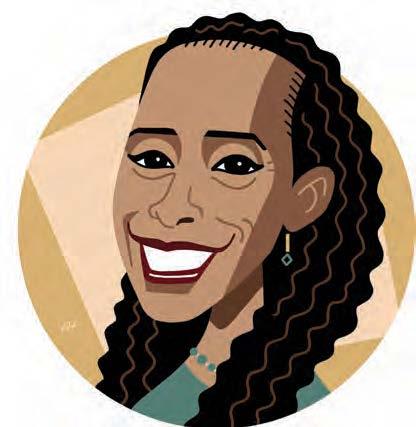
“It is pushing all of us beyond what we thought we were capable of guring out,” she said. “In the end, New Yorkers will be proud we were able to stabilize people and protect the budget and infrastructure.”
When not dealing with the migrant crisis, she is working on measures to keep more families from entering the child welfare system. She has also launched the Citywide Doula Initiative, which o ers free access to doula services in 33 neighborhoods with the greatest need, and the Midwifery Initiative in both public and private hospitals.
But that’s only her day job. She is also the James R. Dumpson Chair in Child Welfare Studies at the Graduate School of Social Service at Fordham University. Williams-Isom serves on the boards of numerous organizations that rely on her expertise and experience, including the nonpro t Child Trends; Columbia University Entrepreneurship, Innovation, and Design; the Central Park Conservancy; Graham Windham; the Collegiate School; the Metropolitan Montessori School; the Partnership Schools; and the Board of Fellows of Weill Cornell Medicine.
e theme of her work for the city, as well as in schools and nonpro ts, she said, is human connection, especially with people who need help. We all have power, she said, adding, “It’s how you use your voice as an instrument to serve.”
She has run four marathons since 2000 and plans to run her fth this year, on her 60th birthday.
—Judith MessinaPresident and CEO, Partnership for New York City
REACH: 330 CEOs and business leaders in New York City
WHAT’S NEXT: Creation of more affordable housing and increasing the affordability of living and running a business in New York City
WHEN KATHRYN WYLDE calls, CEOs — and politicians — pick up the phone. Wylde speaks for the businesses that together employ more than 1 million New Yorkers as president and CEO of the Partnership for New York City, the city’s premier organization for business leaders.
ose employers pay taxes that underwrite half of the city’s budget and, in these post-Covid days, are working hard to keep New York a dynamic and welcoming place for investors, businesses, tourists — as well as everyday New York ers. e name “partnership” speaks to its mission and its method: to build collaborative relationships among businesses, government and nonpro ts to solve problems and address the needs of the city and its inhabitants.
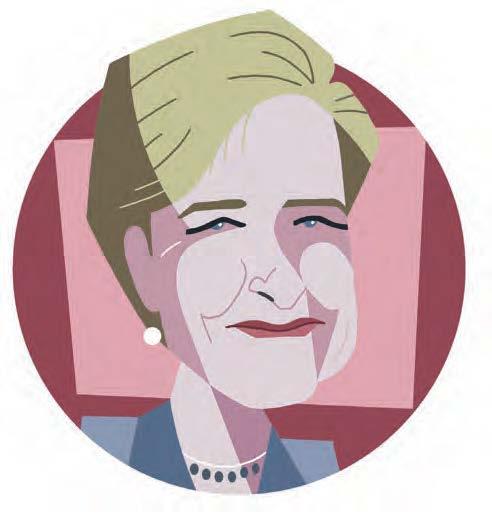
Wylde had built her expertise in housing, economic development and urban a airs before joining PFNYC in 1995 to lead its investment fund and housing e orts. In 2000, she was named CEO. On her watch, the organization has used its expertise and money to fund development of technologically “smart public transit,” help the homeless, underwrite ntech and bioscience startups, and support computer science training and workforce development programs.
Over the past year, PFNYC has put a lot of energy into Mayor Eric Adams’s administration, in particular his We Love NYC campaign. It’s an attempt to restore con dence after the city lost 40,000 lives and almost one million jobs to the Covid pandemic.
“We were promoting the celebration of the people and the strength of the city to combat the negativity . . . and restore a sense of optimism about the future of the city,” Wylde said.
She also serves on the boards of the Fund for Public Schools, Invest Puerto Rico, the Manhattan Institute for Policy Research, the city Economic Development Corp. and the city Regional Economic Development Council. A member of the MTA’s Tra c Mobility Review Board, she is guiding the new congestion pricing law, famously telling the opposition in New Jersey to “get over it.”
—Judith Messina
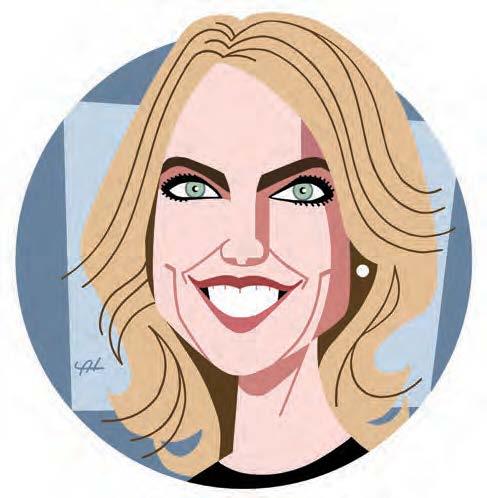
REACH: More than 60 companies signed GLAAD’s joint statement of support for LGBTQ people in June 2023.
WHAT’S NEXT: GLAAD has created a veyear strategic plan to scale up operations and impact.
A LOT HAS CHANGED in the decade since Sarah Kate Ellis became CEO of GLAAD in 2014. Ellis likens the early years to being on a train that was nally picking up speed: the U.S. Supreme Court decision on marriage equality in 2015, more diversity and inclusion for members of the LGBTQ community, and an increase in transgender awareness across the country.
“ ere’s so much increased visibility
— I think we’ve moved in really incredible ways forward,” Ellis said. But so far in the 2024 legislative session, 478 anti-LGBTQ bills have been introduced in states across the country, according to the American Civil Liberties Union’s tracker. “I feel like it’s been a dramatic turn,” Ellis added. “ ere’s a lot to protect now, and there’s a lot of opposition coming to take away the rights that we worked so hard for.”
Ellis joined GLAAD after 20 years working as an executive at Condé Nast and Time, just as she and her wife were starting their family. “I felt as though it was time to do something di erent that protected my family, that created a better world for my family,” she said.
What that has looked like was growing GLAAD from a media watchdog organization into an agent for equitable representation of the LGBTQ community on a national level, and increasingly, a global one. GLAAD worked with Pope Francis who, in December, said Catholic priests could bless same-sex couples.
“There’s a lot to protect now, and there’s a lot of opposition coming to take away the rights that we worked so hard for.”
Other achievements Ellis points to were bringing the organization to the World Economic Forum at Davos and starting a media institute for consultancy and think tank work.
Ellis has also moved toward expanding the organization’s news rapid response and election work. e 2024 presidential election is shaping up to be a busy one, focusing especially on messaging and educating on issues relating to trans people.
“Even though so much has changed, so much progress has been made, our vision and our mission remain the same,” Ellis said. “Because visibility and representation are at the center of acceptance and equality.”
—Olivia BensimonREACH: 63% of the candidates the NYLCV endorsed in 2021 primary elections won their races.
WHAT’S NEXT: Move forward on congestion pricing and the passage of laws for a clean fuel standard for transportation, smart packaging and wastereduction recycling
FOR JULIE TIGHE, even the occasional bad day has its payo : “Every day may not be a great day, but every day I know I’m working on something good.”
A stalwart champion of the environment, Tighe works every day — the good days and the bad — to improve the air New Yorkers breathe, the water they drink and the land they live and work on.
At the New York State Department of Environmental Conservation from 2007 to 2018, she helped reform the state’s brown eld cleanup program, achieve reauthorization of the state superfund program to clean up hazard waste sites, shape New York’s Clean Water Infrastructure Act, and bring forth a comprehensive electronics recycling law.
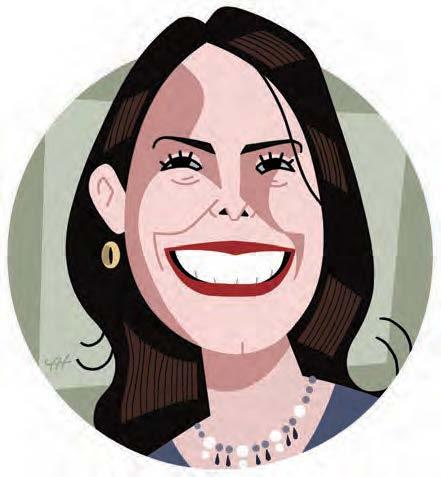
Now as president of the New York League of Conservation Voters since 2018, Tighe has continued her campaign to clean up and preserve the environment for present and future generations. e league’s support helped pass the $3 billion Restore Mother Nature Bond Act and the Accelerated Renewable Energy Growth and Community Bene t Act. In 2022 she helped spearhead a coalition of labor, business, environmental and civic groups to pass the $4.2 billion Clean Water, Clear Air and Green Jobs Environmental Bond Act, which provides funds to protect water quality, reduce pollution and create green adaptations to climate change.
Even as New York has stepped forward as one of the most progressive states on environmental stewardship, Tighe still has a long to-do list. Her organization publishes a policy agenda for state government each year and follows that up with a scorecard of how each issue fared, and which of the Legislature’s 213 members and 51 City Council members were most supportive of the league’s goals.
e scorecard has become a crucial accountability measure at election time, where the $2.4 million organization punches above its weight.
Tighe focuses on using her in uence to push for a shared agenda.
“What you bring to the table for others around you is important,” she said. “I am trying to use my tools to help my organization and groups that I am working with to help everyone achieve goals.”
REACH: 2,400 listed companies with a total market cap of $35.7 trillion
WHAT’S NEXT:
Continuing to stay close to customers and hearing stress points and concerns – and acting on them
IN EACH OF THE TWO YEARS that Lynn Martin has been at the helm of the New York Stock Exchange Group, more companies have transferred to the NYSE than in any other year.
at includes the second-largest transfer in its history, that of P zer from the Nasdaq. e NYSE is also now winning transfers globally. is year, Flutter Entertainment, the holding company of FanDuel, moved its listing from the London exchange.
“Community is the big reason,” Martin said.
—Judith Messina
e NYSE is the world’s largest stock market; the group includes two options exchanges and four electronic equity markets. Martin is a veteran of IBM, the London International Financial Futures and Options Exchange and NYSE parent the Intercontinental Exchange. She is also chair of Fixed Income & Data Services at ICE, bringing both technological and nancial savvy to the table.
Indeed, among her recent accomplishments is what she calls a refreshment of NYSE’s technology, completed last October. Today, Martin said, the average response time for three-quarters of a trillion electronic orders, quotes and trades on a give day is 75 microseconds.
“It’s the human interaction, being able to interact with technology, that is incredibly important in the age of arti cial intelligence,” Martin said. “How to give humans the tools to interact with data and make higher-value decisions with good technology.”
In mid-2022, Martin launched the NYSE Institute. Calling it a pro-business, non-partisan organization, she said it brings the business community together with global policy makers “to make sure they don’t lose sight of the contributions companies make to local economies.” Among the policy makers who have participated are Secretary of the Treasury Janet Yellen, Secretary of Commerce Gina Raimondo, former speaker of the House Kevin McCarthy and the prime ministers of Japan and Vietnam.
Her guiding philosophy? “Keep markets open, e cient and transparent,” she said. “Don’t stray from the north star and make sure information continues to ow freely.”
—Judith MessinaChief medical of cer, New York City
REACH: 8.26
million New Yorkers, especially people who have experienced marginalization
WHAT’S NEXT:
Reducing inequities in premature mortality and continuing to address health equity outcomes for all New Yorkers
ONE OF THE FIRST THINGS Dr. Michelle Morse accomplished when she started as the city’s rst chief medical o cer in 2021 was to work with the city Board of Public Health to have racism declared a public health crisis. ree years later, diversity, equity and inclusion initiatives are facing a massive backlash across the country’s universities and industries, and health and racial equity have not been spared.
“Over the past three years, the pendulum has swung back in many ways from health equity,” Morse said. “Part of what I think it’s my role to do is to not allow that backpedaling to take our work backward in any way and instead to say, ‘ is is a commitment.’”
“I think we went from o ense to defense in some ways in the movement for health equity,” Morse added. “But as any sports fan knows, defense sometimes is just as important as o ense.”
e rst year of her job was fully concentrated on the city’s emergen cy response to the Covid-19 pandemic, but Morse’s focus has continued to evolve with the needs of the city’s 8.3 million residents.

Her aim is to bridge the gap between public health and health care by emphasizing health equity. Covid-19 made it clear that the “siloed nature” of the city’s public health and health care systems had undermined its response to the crisis, Morse said, and more needed to be done to address health equity in the city.
She has the additional title of deputy commissioner in charge of the Center for Health Equity and Community Wellness, which is focused on reducing premature mortality and ending racial inequities in the leading causes of preventable death.
“Just because the societal conversation and the political conversation is shifting, or because this work is now more scrutinized or attacked, it’s actually more important than ever that we defend it, strengthen it and continue to do it,” she said.
—Olivia Bensimon“I think we went from offense to defense in some ways in the movement for health equity.”

Crain’s will celebrate leading women who are poised to have a substantial in uence on New York City and their industries in the coming year. Along with 10 women chosen by Crain’s newsroom, this event will honor 25 nominees in three categories: WomenForward Workplaces, Mentors and Rising Stars. Winners in each category will be revealed LIVE at the lunch.
DETAILS
Location: Marriott Marquis, 1535 Broadway, New York City
CrainsNewYork.com/WOI24


This award recognizes women who have successfully lifted up multiple other women in their careers and in the wider community, by giving their advice, time and mentorship and by advocating for policies that help women move into leadership.
Eve Burton
EVP and chief legal of cer, Hearst
This award recognizes emerging leaders at a New York City-area company or organization who have promoted programs or initiatives advancing women.
| Lauren DeFazio
Eve Burton believes that while mentors are essential, the real magic happens when sponsors help break through barriers and ensure seed ideas take root. With the awareness that less than 2% of venture funding goes to womenled companies, Burton saw more opportunity than obstacle.
A pplying her woman-forward resolve, Burton launched HearstLab to invest in, sponsor and scale early-stage female founders. Burton took a hands-on approach to the mentorship and drove HearstLab to invest in more than 70 female-founded companies globally in just seven years with a collective valuation of $2.5 billion.
Throughout her more than 21 years at Hearst, every team managed by Burton has been at least 50% women. Burton recently composed the Hearst Scout Network, an organization of over 160 women leaders and executives from Hearst businesses around the world. Within this network, accomplished women exchange insights, methods and new opportunities to grow and succeed.
Beyond her Hearst contributions, Burton created the Helen Gurley Brown Foundation with the late Brown, former chief editor of Cosmopolitan magazine. The foundation they built provides college scholarships and grant funding to help women step into their power and become leaders in their industries.
For more than 12 years, this in uential foundation has elevated women into leadership positions on college campuses and in science, medicine, the arts and more.
Ana Oliveira President and CEO, New York Women’s FoundationWith her resonant belief that those closest to the problems are also closest to the solutions, Ana Oliveira puts the po wer for change in the hands of women with lived experiences of the challenges her organization works to address.

Embracing trust-based philanthropic practices, Oliveira leads the New York Women’s Foundation in creating an equitable and just future for women, girls and gender-expansive individuals and their families. As president and CEO, Oliveira has steered the foundation to resource and support women-led, grassroots organizations throughout New York City, reinforcing their efforts to achieve gender, racial and economic equity in the city’s most impoverished and underserved communities.
Since she joined the foundation,
Oliveira has increased its investments from $1 million to $10 million per year. She was also instrumental in the creation of The NYC Fund for Girls and Young Women of Color. Since its inception, this fund has provided a platform for more than 20 funders to invest more than $12 million in over 60 organizations run by and for girls and young women.
GYWOC grew out of the NYC Young Women’s Initiative, another program Oliveira helped create to make longterm investments in New York’s young women and girls in collaboration with The Foundation, nonpro t partners and the New York City Council.
Julie Samuels
President and CEO, Tech:NYC
Julie Samuels is playing a leading role in moving women forward in the technology industry. Through the networking events she convenes, Samuels brings together prominent women in the eld and emerging leaders at the start of their careers to drive inclusive gro wth.
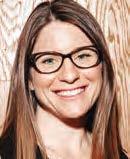
Bergen New Bridge Medical Center by 33%. Under Visconi’s leadership, the medical center also appointed its rst female associate chair of medicine.
Furthering her efforts to help promote women, Visconi established Bergen New Bridge’s formal mentoring program, contributing to a 50% increase in female senior staff members. Visconi believes mentoring methods should be as unique as the individual being mentored. By understanding each mentee’s unique aspirations and growth potential, she’s able to provide support and guidance in a kind and genuine manner.
As a female Latinx CEO, Visconi is committed to hiring and advancing women from marginalized groups and increasing the visibility of female leadership in the medical profession. She serves as an example for aspiring female leaders to see themselves in when she gives interviews and speaks at events such as the YWCA Northern New Jersey, which honored her for her leadership in 2022.
By mentoring women with the American College of Healthcare Executives and the Essential Women’s Leadership Academy for America’s Essential Hospitals, Visconi proves her commitment to amplifying the female voices of the future.
As president and CEO, Samuels and Tech:NYC launched Founder House, an initiative designed to support underrepresented founders working toward their rst venture ca pital investment. So far, 46% of participating founders are women. With women holding less than a quarter of all tech jobs in New York City, this percentage of female founders is especially noteworthy.
Samuels rallied Deputy Mayor Anne Williams-Isom and roughly 20 female health tech founders to initiate a Women’s Health Summit. More than 100 experts participated in discussions about essential women’s health topics, including chronic disease, birth equity, reproductive health and mental health.
As Samuels’ work with Tech:NYC helps grow the tech industry in New York, the city cements its status as a global hub for women’s tech, specically the women’s health tech sector.
“Her drive, creativity and fearlessness has helped make the New York City tech ecosystem more welcoming for women than any other tech hub in the country,” said Reshma Saujani, founder of Girls Who Code and a longtime supporter. She added that the critical work of elevating women in tech is more accessible with Samuels on their side.
Since her arrival in 2017, president and CEO Deborah Visconi has increased the number of female physicians at
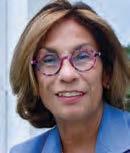
Ny Whitaker
Founder and chief strategist, Project NYNE
Ny Whitaker pursues her calling to elevate women and girls of color on their professional journeys with purpose and devotion.

As a mother, mentor of many, former White House presidential appointee, founder and chief strategist of Project NYNE and a professor at NYU, Whitaker’s tenacity has helped women excel. Whitaker bridges academia and industr y by activating her professional network to make personal connections for her mentees. She also provides valuable real-world experience via paid internships and employment. In turn, Whitaker has helped her students and colleagues secure positions in New York government, the White House, nonprofits, corporations and the campaigns of Barack Obama, Hillary Clinton and Joe Biden. Whitaker personally recruited and trained more than 70,000 virtual volunteers for Biden’s campaign during the pandemic. She received recognition from former President Obama for her contributions to education reform as a founding charter school parent.
Her active involvement with Vote Mama, an organization dedicated to recruiting, training and funding mothers as they run for public of ce, helps amplify female representation across the political landscape. Over the past ve years, Whitaker has helped 22 women run for of ce and win.
Emily Green
Head of private wealth, Ellevest
been so successful that a second wave of sponsees is underway, with plans to expand to other regions.

Helping women achieve nancial strength and independence was a high priority for visionary Emily Green when she started Ellevest’s private wealth management business with support from Dr. Sylvia Kwan, chief investment of cer.
During her years on Wall Street, Green worked with and learned from some of the most successful professionals in New York. She also became acquainted with many women in leadership positions who struggled to maintain control over their wealth. With a keen understanding of the challenges women face in building wealth and retaining their power, Green began her mission to change the nancial landscape shaped by men more than a century ago.
Delivering on her pursuit, Green has led the charge in developing the Ellevest Intentional Impact portfolios. This initiative paves the way for investors to move their money a way from companies whose practices don’t serve women or people of color and reallocate investments toward businesses tha t do. By design, this solution allows women to use their wealth to invest in other women.
Green also hosts dinners and events where open conversations ow naturally on various nancial topics affecting women. These gatherings have led to business opportunities, mentorships, friendships and connections between women who may not have crossed paths otherwise.
Leslie Kalucki
National director of human resources, Skanska
Leslie Kalucki supports upward career mobility for women in construction by breaking through the barriers in this predominantly male industry.

As a human resources business partner and an advocate for career advancements, Kalucki challenges and rede nes traditional selection processes, offering alternatives that the leadership team had yet to consider. She also places a thoughtful emphasis on nurturing the growth of emerging female leaders.
By championing women in key developmental opportunities, Kalucki furthers a more inclusive and diverse leadership landscape within the organization. Kalucki drives female sponsorship in Skanska’s New York of ce with a program tha t pairs women with in uential sponsors. The program has
Leveraging her advocacy beyond Skanska, Kalucki is a member of the Women Builders Council, where she helps clear a path for female professionals in New York’s building industry. She also works with local cha pters of the Society of Women Engineers to host informational sessions, resume reviews and college-campus career fairs that connect women with industry professionals. Through this SWE collaboration, Kalucki helps maintain a pipeline of talented female candidates for internship and full-time opportunities.
Allie Moogan
Social responsibility manager, New York Liberty
As New York

Liberty’s social responsibility manager, Allie Moogan believes in a workplace where women show up as their most authentic selves and feel like they truly belong in the world of sports. Through her dedication to breaking the glass ceiling and addressing gender bias and stereotyping in sports, she helps make this vision a reality for the women of New York Liberty.
Within the Liberty organization, Moogan initiated pronoun training in collaboration with global LGBTQ+ health care leader Callen-Lorde to help ensure all employees feel comfortable and accepted. Moogan also put together a program where New York Liberty partners with nonpro ts to mentor women aspiring to thrive in the industr y. This initiative was also designed to show women the kinds of roles tha t are attainable by connecting them with established female sports and business professionals.
Moogan’s outreach efforts extend across all ve boroughs through the clinics she leads for girls ages 8 to 17. These youth girls’ clinics use basketball to build con dence, promote health and wellness, and provide opportunities for young girls to learn and play.
“We have never had someone join the team and exude such passion internally, while enacting such widespread positive impact externally,” said Br y an Flannery, New York Liberty public relations manager.
Jovia Radix-Seaborough SVP of corporate and legislation, Kasirer
Advocating for those who are underserved and underrepresented goes beyond Jovia RadixSeaborough’s SVP title; it’s in her DNA.
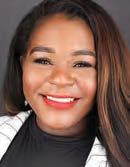
As women continue to face nationwide underrepresentation in the legal eld, Radix-Seaborough doubles down on her charge to uplift female professionals in her industry.
Over the past ve years at New York City’s top lobbying rm, Radix-Seaborough’s leadership and persistence have been instrumental in fostering positive change for the women she mentors, the clients she represents and the greater New York community.
Showcasing her ability to in uence important policy decisions, RadixSeaborough played a pivotal role in the city’s recent e-cigarette ban. She serves as vice president of the Thomas Jefferson Democratic Club Young Democrats, where she works to improve the quality of life for southern Brooklyn residents. Last year, she was named Thomas Jefferson Woman of the Year. Radix-Seaborough’s mother served as the rst black president of the Wom-
en’s Bar Association. Following in her mom’s footsteps, Radix-Seaborough assumed that same role and responsibility to amend the lack of diversity in the legal eld.As president of the Women’s Bar Association, RadixSeaborough is committed to ensuring tha t the door remains open for future generations of women of color to pursue leadership paths.
As women continue to face nationwide underrepresentation in the legal eld, Radix-Seaborough doubles do wn on her charge to uplift female professionals in her industry.
Ingrid Walker-Descartes
Vice chair of education, Department of Pediatrics; program director, Pediatrics Residency, Maimonides Health
By training the next generation of pediatricians and developing Maimonides Medical Center’s comprehensive child abuse ser vices, Dr. Ingrid Walker-Descartes has enhanced safety and equity for patients, families and medical professionals.

Through her clinical role, WalkerDescartes proves her passion for
improving the lives of girls and women in the community by providing care to victims of sexual assault, most of whom are females under 18. Through her activism, Walker-Descartes drives providers, students, residents and fellows to take action against sexual abuse and intimate partner violence, which also affects women at a higher rate than men.
She demonstrates her dedication to women’s well-being by raising awareness of workplace challenges affecting those historically underrepresented in the medical eld. Since 2014, WalkerDescartes has given lectures such as “The Juggling Act – Motherhood and Medicine” to address the strains disproportionately affecting women and mothers in the eld.
In 2017, she authored and implemented Objective Structured Clinical Examina tion training for medical residents to advocate for themselves, colleagues and patients during professional challenges. Walker-Descartes has presented her OSCE development methods at local, state, regional, national and international meetings.
“Dr Walker-Descartes is a xture within Maimonides Children’s Hospital, and a true advocate for vulnerable children here in Brooklyn,” says Dr. Jeffrey Avner, chair of pediatrics at Maimonides Children’s Hospital.
This award recognizes organizations in all industries, with less than 250 employees, that have committed to women having a voice in planning and operations. The organizations have programs, initiatives and policies that advance women in the workplace.
In 2023, with the elevation of incumbent managing partner Terri Adler and their Adler & Stachenfeld rebrand, A&S became one of the only powerhouse law rms in the New York market with a woman name partner.
Attracting, retaining, and promoting talented women attorneys is a top priority at A&S, as indicated by the various leadership roles women have been appointed to across the real estate law rm, from nearly half of their co-chairs to their entire administrative management team.
As various studies have shown, women are more likely than men to bear caregiver responsibilities and often pay the price in their professional lives as a result. With awareness of this disparity, the rm has cultivated a workplace that is more conducive to women’s lives. A&S aims to amend the disproportionate impact that time off and re-
By | Lauren DeFazio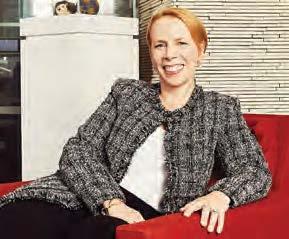

entry has on women in the workplace and a pproaches resolutions with consideration and innovation. For those taking on added caregiver responsibilities, the rm offers a decelerated partner track that temporarily slows an
See SMALL on page 18



attorney’s career acceleration without forcing them to reset their careers and work from the ground up.
By offering this alternative growth avenue, A&S has been successful in retaining and elevating many top women attorneys.
Despite relatively few female engineers in New York’s construction industry, Agencie is a woman-owned architectural and engineering rm with a 60% female staff.

Under the leadership of co-founder Sarrah Khan, Agencie consistently works on major projects to increase the visibility of female engineers on the job site and in the design of ce. Their most notable projects have included the Urban Umbrella, the new Terminal One at JFK Airport, the historic AKA Hotel at Times Square, and Gucci stores across the U.S. Khan works with top industry leaders to set a new standard for women in the industry. “While great strides have been made to increase the diversity of the job site, more and more women must recognize that architecture and engineering is a real career path for our daughters and granddaughters,” said Andres Cortes, principal architect. The rm delivers on this vision by holding training sessions that teach the importance of networking informally to develop meaningful connections.
With the insight that women often prioritize household responsibilities in the evenings, Agencie hosts networking opportunities almost always during of ce hours. When networking occasions occur in the evenings or on weekends, the activities are designed to be child-friendly. The rm’s primary networking event is an annual ski trip that includes lessons and lift tickets for employees and their families.


the top investment management rms and partners, who have invested a collective $13 million in the long-term retention and advancement of women and non-binary investors.
With continued efforts toward retention, GWI launched the Alumni Career Portal in 2022 to support alums beyond graduation by connecting a network of peers with job opportunities and leadership training. GWI also works hand-inhand with more than 120 partner rms to shape company cultures that back women through mentoring, sponsoring, pay transparency, cognitive diversity and long-term career path planning.
Hot Bread Kitchen
With a mission to uplift immigrant women and women of color, Hot Bread Kitchen provides economic opportunity through job training and placement, food entrepreneurship programs and an ecosystem of support.
To help women succeed in the male-dominated culinary industry, this nonpro t organization breaks ground by partnering with trusted employers to place women in jobs with aboveaverage wages and competitive benets. Over the past two years, HBK has placed hundreds of women. In 2022, HBK launched an ambitious strategic plan to reach 1,000 new members by the end of 2024, and the organization is on track to exceed this goal.

Hot Bread Kitchen is aware of the historical barriers that have made it unjustly dif cult for women to succeed as entrepreneurs. To overcome the obstacles women of color and immigrant women face in owning and operating their own ventures, Hot Bread Kitchen introduced HBK Incubates. Led by a team of women of color, this small business accelerator program exists to foster long-term generational wealth and provide holistic support throughout the lifespan of a small food business.
to evolve workplaces and enhance human health and well-being for employees. The Well Equity Rating empowers companies to take action and drive accountability toward diversity, equity, inclusion and accessibility goals.
Many of the institute’s features address gender equity in the workplace by supporting breastfeeding mothers, equal pay and generous maternity and paternity leaves. Other features help organizations integrate social sustainability into their culture, strategy and corporate reporting.
The institute demonstrates its commitment to embracing the same social values it carries to businesses around the world. The organization does this by supporting women with a hybrid work model and dedicated nursing rooms for support while transitioning back to work from maternity leave.
The institute has created a workplace where women are welcomed and destined to thrive. With an organization that’s 86% female and an executive leadership team comprised of 58% women, this organization demonstrates that having women at the top has helped them attract more female candidates who can see themselves re ected in leadership.
Jones Day

For the fourth consecutive year, Jones Day was named a “Ceiling Smasher” by Law360 for having one of the top percentages of female equity partners in law rms of a similar size. “Our culture supports and encourages women to be leaders in their practice, the rm and their community,” said Yvette McGee Brown, partnerin-charge of diversity, inclusion and advancement.
Jones Day’s rmwide Women’s Af nity Group and its Women’s Initiative organize panel discussions where women who make partner each year connect about the challenges and triumphs they’ve experienced along the way. This event re ects the high percentage of Jones Day partnership classes comprised of women each year. For example, in 2023, the U.S. new partner class had more than 50% female enrollment.
I’ve never seen before,” said Ashley Cotton, principal of MAG Partners. The rm’s Diversity, Equity and Inclusion Committee fosters an environment that helps create a sense of belonging for employees. Generous paid family leave, stipends for continued education and an overall nurturing culture for parents and caregivers add to the rm’s efforts

to ensure that employees feel valued, respected and empowered.
With its 53% female staff, MAG Partners prioritizes hiring and promoting women across the organization. In fact, women are represented in every department, from construction and corporate operations to accounting and property management. Women also lead the public affairs, development, community and human resources departments.
Gilmartin also makes herself available for mentorship programs, leadership training and real estate industry events where she shows young women professionals that female leadership is within reach.
At the Real Estate Board of New York, women across all levels of leadership have a seat at the table to raise issues and be a part of the solutions that move the organization forward.
REBNY has cultivated a space where female C-suite and senior vice presidents take a hands-on approach to guiding junior staff toward a vertical career trajectory. Last year, REBNY launched Women at REBNY, a speaker series that invited female leaders in real estate to share insights from their careers.


With a space that exudes femininity and a small-but-mighty, mostly female team, Terez brings women together for in-person connections. Monthly celebrations honor mother entrepreneurs and young girls participating on The Voice and in the Day of Girl.
At Terez headquarters, a “You Can Sit With Us” sign serves as a reminder of the brand’s mission to encourage women to celebrate all of life’s bright moments. Furthering a pledge to spread positivity, this year Terez partnered with one of the largest providers of shelter and housing for New York City’s homeless women and children by donat-

ing a piece of clothing for every item purchased at the agship store.
Last year, Terez brought women’s and girls’ fanwear into the spotlight through its partnership with Major League Baseball. The brand launched collections for eight teams, giving female fans the chance to aunt their team spirit with fun, fresh clothing. The partnership was so successful that Terez plans to release a new line for more MLB teams and stadiums this year.
Founder of The Designers Group Blima Ehrentreu has created an open and collaborative work culture where challenges are faced head-on, victories are celebrated as a united team and women thrive in a male-dominated eld.
Girls Who Invest is unwavering in its commitment to advancing the next generation of women aspiring to work in the investment management industry, from entry level to the C-suite. This woman-founded, women-led nonpro t organization lays the foundation for young professionals to succeed by offering college-aged women and nonbinary students two, tuition-free education programs that provide academic training and paid internships. As of 2023, the organization’s alumni community grew to more than 2,500 women. 70% are working full-time in the industry, and 60% are people of color.
Long-term career paths are essential to GWI’s vision for 30% of the world’s investable capital to be managed by women and non-binary investors by 2030. To help facilitate this goal, the organization started the GWI Leadership Circle, an advisory and donor group of
With its 83% female staff, HBK has created a work environment by and for women that mirrors the environment it cultivates for its members.
The International Well Building Institute is on a mission to transform communities by fostering people- rst places. The institute’s vision to forge a more equitable, just world is at the core of its innovative initiatives.
Through the Well Building Standard, the institute offers a roadmap designed

The Women’s Initiative also hosts forums that address issues ranging from working with clients and career development to reproductive rights. The initiative devotes time and resources to charities focused on women’s issues. Examples include organizing clothing and food drives, and offering pro-bono legal services to women in need. The initiative also helps its female employees connect by coordinating events designed to foster informal mentoring, including book clubs, charitable events and happy hours. As of December 2023, women make up 43% of Jones Day’s U.S. lawyers.
MAG Partners is a female-founded construction and development company in New York City. CEO Maryanne Gilmartin created and maintains a diverse, inclusive and equitable work culture at MAG Partners, bringing decades of experience to a male-dominated industry.
“It’s not about a program or initiative, this is in the company’s DNA in a way
Over the last two years, 55% of the women at REBNY have received promotions and salary increases. In celebration of Women’s History Month, REBNY proudly promotes the impact of women by featuring female staff achievements across its social media channels, reaching more than 94,000 followers.
REBNY exempli es its pledge to nurture its employees’ growth by offering a tuition reimbursement program; 67% of participants are women. Of the most recent intern class at REBNY, half were women. Additionally, 90% of REBNY committees are led by women, 70% of its workforce and 55% of senior leadership are women.
“We are also proud to be at the forefront of efforts to elevate the next generation of women leaders in New York City’s real estate industry at large,” said Colleen Slattery, senior vice president of human resources.
Terez
What began with a dream in her parents’ basement in 2008 has blossomed into much more than a chic Upper East Side clothing store. Zara Terez Tisch founded Terez and created the joy she wanted to see in the world with this place where positivity radiates, like the vibrant pink walls of its agship store.
With a vision to address gender disparities in the real estate industry, this company has driven several effective initiatives to promote women. The TDG Build service, for example, empowers female designers to showcase their

budget management, vendor relations and project oversight skills by providing opportunities to lead projects from design to execution.
TDG also demonstrates its commitment to professional development within its community with programs like TDG Gives Back, Furniture Exchange and TDG Insider. This female-majority rm’s success is evident in the culture of appreciation and acknowledgement it has inspired with programs such as TDG Stars, which recognizes exceptional employee achievements.
TDG’s hybrid work model is another testament to the rm’s supportive and connected work environment. Though it may have originated as a practical response to pandemic challenges, this strategy also strengthened team dynamics, increased the ef ciency of real-time interactions and bolstered the collaborative spirit at TDG.
This award recognizes organizations in all industries, with more than 250 employees, that have committed to women having a voice in planning and operations. The organizations have programs, initiatives and policies that advance women in the workplace.
AMC Networks
AMC Networks prides itself on providing women with a workplace that sees, values and helps them reach their full potential. From internal programs that foster career acceleration to formal and informal mentoring opportunities, women in leadership at AMC Networks are nurturing the gro wth of female talent at every level.

Women working at AMC Networks also receive health care, well-being, nancial and family-building support bene ts that help them live ful lling lives. “AMC Networks has given me more than just a career. It’s given me the opportunity to grow as a woman, to be a wife, a mother and now, an executive,” said Chief Marketing Of cer Kim Granito.
Blazing trails in-house and on the big screen, AMC Networks is empow-
By | Lauren DeFazio“AMC Networks has given me more than just a career. It’s given me the opportunity to grow as a woman, to be a wife, a mother and now, an executive.”Kim Granito, chief marketing of cer
ering women to succeed in traditionally male-held roles.The company has put female powerhouses front and center to change the way the world often sees, hears and perceives women. They also proudly partner with the SeeHer movement, which strives to promote realistic portray als of women in media.
AMC Networks has a workforce that’s 51% female and leadership roles that are held 60% by women. In
2022, the Women in Cable Telecommunications Network recognized AMC Networks as one of the Top Companies for Women to Work.
Progyny
As you might expect from a fertility, family-building and women’s health bene ts company, Prog yny takes care of the women outside and inside its organization. “Fostering a female-forward workplace is part of Prog yny’s DNA,” said Chief Marketing Of cer Risa Fisher. With an 80% female workforce, Prog yny understands that supporting women means providing bene ts beyond the traditional. That’s why Prog yny offers paid leave for employees who have suffered a pregnancy loss, paid leave for employees with a child in a neonatal intensive care unit, and comprehensive fertility and family-building coverage, including surrogacy and adoption reimbursement and egg freezing. The company also offers menopause bene ts and nancial
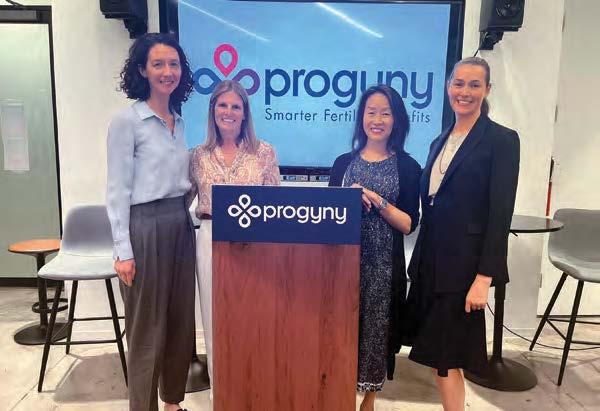
support for needs such as hospice care, childbirth classes and childcare costs. Progyny champions women by celebrating their achievements and taking action on pressing issues. The company’s commitment to fertility and maternal health awareness drove the founding of an International Fertility Awareness Week panel and a Black Maternal Health panel. Progyny also organized Menopause, Parenthood, Fertility, Family Building, LGBTQIA+ and
BIPOC employee resource groups where employees can share experiences, seek guidance and access resources.
Regeneron
Leading biotechnology company Regeneron is committed to promoting female leadership within its organization and throughout its industry. Regeneron has spearheaded initiatives designed
See LARGE on page 20



to address the challenges women in leadership face and implement equitable pay practices. The company also provides leadership skills training to external organiza tions.
Regeneron created several programs to provide opportunities for women across the company to listen, learn and connect informally. These conversations have prompted the company’s co-founder and senior leaders to make tangible commitments that enhance workforce and culture goals.
Executive Vice P resident and Chief Human Resources Officer Sally Paull is a driving force behind Regeneron’s woman-forward present and future. Since joining the company in 2016, her efforts have resulted in a 33% increase in women in leadership positions, greater female representation a t all levels across the organiza tion and the introduction of health and financial benefits uniquely suited to women.
Paull’s support contributed to Regeneron being named one of America’s Greatest Workplaces for Diversity by Newsweek and a Best Place to Work for Disability Inclusion by the American Association of People with Disabilities. Regeneron was also ranked among the Top 100 DEI Leaders of In uence and named one of the Top Female-Friendly Companies by Forbes.

Ropes & Gray Ropes & Gray has long been recognized as a rm that propels female attorneys to the pinnacle of legal practice. With an all-equity partnership comprised of 33% women, above the industry average of 22%, Ropes & Gray secured the top spot globally for female representation last year by the Financial Times.
Over the past ve years, Ropes & Gray demonstrated a noteworthy 7.6% increase in female partners. Across the rm, 19 group leaders, eight chiefs of support departments, six of ce managing partners and four governing policy committee members are women.
Twenty- ve years ago, the rm established Ropes & Gray’s Women’s Forum to help women progress in their careers through skill development and relationship-building. As junior associates navigate their new positions — some also new to parenthood — they nd comfort and con dence at Paths to Partnership Panels hosted by the Women’s Forum. Here, women partners answer questions and share their unique career journeys.
In its second year of support, the rm’s Black Women La wyers Group hosted a retreat with a keynote speaker who discussed the challenges black women face in the industry and how to overcome them. Women’s Forum Wednesdays launched in 2022 and draws hundreds of women to share challenges and celebrate successes.
SiriusXM
Within its organization, SiriusXM approaches recruitment, employee development and workplace initiatives with an always-on inclusive lens. The company channels that same dedication to diversity by representing and serving listeners’ cultures, tastes and interests through the programming they air across the nation.
Last March, SiriusXM hosted a Women’s History Month webinar series, “She’s Got the Mic,” covering topics from nancial literacy to fostering an equitable workplace. The broadcasting corporation also promotes corporate social responsibility through SiriusXM Cares. This donor-advised fund contributes to organizations advancing cultural diversity and equity, increasing opportunities for underserved populations, and combatting injustice, including Girls Who Code and The Alliance for Women in Media Foundation.
As part of its health care package, SiriusXM offers reimbursement for 100% of eligible fertility, adoption and gestational carrier expenses up to $35,000 for employees and covered spouses or domestic partners. Continuing its support for the personal lives of its talent, SiriusXM offers year-round half-day Fridays to help employees kickstart their weekends.
Newsweek named SiriusXM one of America’s Greatest Workplaces for Diversity in 2024.

Lauren DeFazio
Gone are the days when a lawyer took an extended leave of absence and had no choice but to restart their career.
Top law rms have begun facilitating “returnships” for lawyers who hit pause on their careers to raise children, care for an aging parent, tend to an illness, or give a life-changing event the full-time attention it requires.
People who take breaks from the workforce often encounter the challenge of not being able to reenter at the same level they left. However, in a tight labor market, the concept of internships for middleaged workers is catching on.
e OnRamp Fellowship gives returning lawyers the opportunity to learn and advance through one-year, paid fellowships with law rms and legal departments. For many lawyers looking to return from leave, having the support of a program like OnRamp feels like the only way back into the eld. Despite impressive credentials and top- rm references, it’s not uncommon for returners to deploy hundreds of resumes and be left with no leads.
OnRamp alum Candice Furnald practices at Akerman in Midtown. Her fellowship made it possible for her to pivot from litigation to transactional real estate, an entirely new practice area.
“OnRamp helped me bridge the gap of being a new mother with two kids under 2 years old, easing into ‘big law,’” she said. “OnRamp provided me with an invaluable opportunity to join Akerman. It has been a rm where I was and continue to be welcomed, mentored, challenged and supported.”

Orrick, Loeb & Loeb and Katten Muchin Rosenman.
“It’s a great privilege to o er a pathway back to practice for these incredibly talented lawyers,” said Lisa Kirby, chief inclusion and equity o cer of Diversity Lab, the incubator that powers OnRamp.
“We are especially proud that nearly 90% of OnRamp’s returners have been o ered permanent positions with their organizations,” she added. “Many of them have advanced into leadership roles in their rms, legal departments and communities.”
A study by the Center for WorkLife Policy found that 73% of women attempting to return to the workforce after a voluntary timeout for childcare or other personal reasons have di culty resuming their career trajectory.
Lawyers traditionally accelerate based on seniority and tenure, so resume gaps become blockades, and a leaky pipeline grows with more women exiting than able to re-enter the legal eld.
“We are especially proud that nearly 90% of OnRamp’s returners have been offered permanent positions with their organizations.”
Lisa Kirby, chief inclusion and equity of cer of Diversity Lab
OnRamp was founded in 2014 and began supporting returnships with four law rms. In less than a decade, the partnerships have expanded to more than 30 law rms and 15 legal departments. Since its inception, the organization has brought more than 120 attorneys back to rms and legal departments in major markets from coast to coast. In New York, OnRamp said it has placed fellows in top rms and well-known legal departments, including American Express, P zer, Sidley, ompson Coburn, Willkie Farr & Gallagher,
Instead of overlooking this vast, untapped network of diverse, talented professionals eager to dive back into their careers, the OnRamp Fellowship became a solution. OnRamp’s purpose is to connect experienced lawyers hungry to grow into leadership roles within leading organizations.
After excelling through OnRamp’s extensive screening process, applicants are matched with organizations where they’re most likely to thrive. Once selected, participants receive careerdevelopment training in negotiations, project management, business development and leadership. Each participant is also paired with a legal career expert for oneon-one coaching to help sharpen
and broaden their skills. Participating in the OnRamp Fellowship also o ers the supportive infrastructure of cohorts where returners can connect, relate and remind each other that they are not alone in the challenges they face.
e fellowship is a win-win for returning lawyers and law rms. While the returners enhance their skills, grow their experience and expand their contacts, the rm housing them has a high-performing lawyer serving clients with renewed ambition. It’s also an excellent way for a lawyer to try a place and see if it’s a good culture t, and vice versa.
At the end of the year, participants will have a current professional reference they can leverage to pursue their next endeavor. If there’s an opening for a relevant, longer-term position, the participant may choose to interview and continue with the same rm.
OnRamp boasts that 89% of participants have received o ers to join organizations upon completion of the fellowship. Many have also gone on to make partner at top law rms or secure senior roles within legal departments.
e program received glowing reviews from alumni in an anonymous survey. “Participating in OnRamp was a true gift — it gave me the con dence and foot-inthe-door to launch my ‘ ird Act’ and build back my professional life,” one raved.
Another re ected, “On Ramp helped my resume stand out and provided that all important ‘foot in the door’ to the interview process. After being hired, On Ramp was there with coaching support and the chance to share experiences with other fellows.”
When companies team up with OnRamp, they acknowledge the challenges posed by re-entry into the profession and the disproportionate impact it has on women.
ey also take crucial steps toward creating a caregiver-friendly work environment.
Notice of Formation of 38 BAT LLC Arts of Org filed with Secy of State of NY (SSNY) on 2/20/24. Office Location: NY County. SSNY designated as agent upon whom process may be served against LLC to: 250 W 81st St, #4B, NY, NY 10022
Purpose: any lawful act.
Notice of Qualification of AL BAHR US LLC
Appl. for Auth. filed with Secy. of State of NY (SSNY) on 03/07/24.
Office location: NY County. LLC formed in Delaware (DE) on 12/22/23. Princ. office of LLC: 1 Vanderbilt Ave., NY, NY 10017. SSNY designated as agent of LLC upon whom process against it may be served. SSNY shall mail process to Corporation Service Co., 80 State St., Albany, NY 12207-2543. DE addr. of LLC: 251 Little Falls Dr., Wilmington, DE 19808. Cert. of Form. filed with Secy. of State of DE, 401 Federal St., Ste. 3, Dover, DE 19901.
Purpose: Any lawful activity.
Notice of Formation of AVB GROUP LLC Arts of Org filed with Secy of State of NY (SSNY) on 12/26/2023 Office Location: NY County. SSNY designated as agent upon whom process may be served against LLC to: The Limited Liability Company, 10 Madison Square west 1107, Broadway Unit 4H,,NY, NY, 10010, USA. Reg Ag.: United States Corporation Agents, Inc. 7014 13th Avenue, Ste 202 Brooklyn, NY 11228, USA.
Purpose: any lawful act.
NOTICE OF FORMATION of CODESIGN & STRATEGY LLC.
Arts. of Org. filed with Secy. of State (SSNY) on 11/08/23. Office location: NY County. SSNY designated as agent of LLC upon whom process against it may be served. SSNY shall mail/email process to: 424 E. 83 ST Apt 1W NY, NY 10028, US; inquiry@codesignstategy.com
Purpose: any lawful activity.
Notice of Qualification of CSP PROPERTIES LLC
Appl. for Auth. filed with Secy. of State of NY (SSNY) on 03/07/24. Office location: NY County. LLC formed in Delaware (DE) on 07/19/23. SSNY designated as agent of LLC upon whom process against it may be served. SSNY shall mail process to c/o Corporation Service Co., 80 State St., Albany, NY 122072543. DE addr. of LLC: 251 Little Falls Dr., Wilmington, DE 19808. Cert. of Form. filed with DE Secy. of State, 401 Federal St. - Ste. 4, Dover, DE 19901.
Purpose: Any lawful activity.
Notice of Formation of ENFYS LLC. Arts of Org filed with Secy of State of NY (SSNY) on 1/30/24.
Office Location: NY County. SSNY designated as agent upon whom process may be served against LLC to: The Limited Liability Co., 228 Park Ave #141700, NY, NY 10003. R/A:United States Corp. Agents Inc.., 7014 13th Ave, Ste 202 Brooklyn, NY, 11228, USA. Purpose: any lawful act.
Notice of Qualification of EAG GULF COAST, LLC
Appl. for Auth. filed with Secy. of State of NY (SSNY) on 03/07/24. Office location: NY County. LLC formed in Delaware (DE) on 03/30/23. Princ. office of LLC: 733 Third Ave., NY, NY 10017. SSNY designated as agent of LLC upon whom process against it may be served. SSNY shall mail process to Corporation Service Co., 80 State St., Albany, NY 122072543. DE addr. of LLC: 251 Little Falls Dr., Wilmington, DE 19808. Cert. of Form. filed with Secy. of State, 401 Federal St., Ste. 3, Dover, DE 19901.
Purpose: Any lawful activity.
Notice of Qualification of GLOBAL PLASTICS, LLC
Appl. for Auth. filed with Secy. of State of NY (SSNY) on 03/14/24. Office location: NY County. LLC formed in Delaware (DE) on 09/24/12. NYS fictitious name:
MGI/GLOBAL PLASTICS, LLC. SSNY designated as agent of LLC upon whom process against it may be served. SSNY shall mail process to Corporation Service Co., 80 State St., Albany, NY 12207-2543. DE addr. of LLC: Cogency Global Inc., 850 New Burton Rd., Ste. 201, Dover, DE 19904. Cert. of Form. filed with Secy. of State, 401 Federal St., Ste. 4, Dover, DE 19901.
Purpose: Any lawful activity.
Notice of Formation of GREENPOINT COFFEE
PURVEYORS LLC Arts of Org filed with Secy of State of NY (SSNY) on 1/2/2024. Office
Location: NY County. SSNY designated as agent upon whom process may be served against LLC to: The Limited Liability Company 228 Park Ave S #562556, New York, NY, 10003, USA. Reg Ag.: United States Corporation Agents, INC. 7014 13th Avenue, Ste 202 Brooklyn, NY, 11228, USA.
Purpose: any lawful act.
Notice of Qualification of TACPP MANAGEMENT LLC
Appl. for Auth. filed with Secy. of State of NY (SSNY) on 02/09/24. Office location: NY County. LLC formed in Delaware (DE) on 08/28/23. Princ. office of LLC: 640 Park Ave., 11th Fl., NY, NY 10065. SSNY designated as agent of LLC upon whom process against it may be served. SSNY shall mail process to the LLC at the princ. office of the LLC. DE addr. of LLC: 251 Little Falls Dr., Wilmington, DE 19808. Cert. of Form. filed with Secy. of State, 401 Federal St.Ste. 4, Dover, DE 19901. Purpose: Any lawful activity.
Notice of Qualification of HANWHA FUTUREPROOF
VENTURES LLC Appl. for Auth. filed with Secy. of State of NY (SSNY) on 03/12/24. Office location: NY County. LLC formed in Delaware (DE) on 03/06/24. Princ. office of LLC: 280 Park Ave., 23rd Fl., East Tower, NY, NY 10017. SSNY designated as agent of LLC upon whom process against it may be served. SSNY shall mail process to Corporation Service Co. (CSC), 80 State St., Albany, NY 12207-2543. DE addr. of LLC: c/o CSC, 251 Little Falls Dr., Wilmington, DE 19808. Cert. of Form. filed with Secy. of State of the State of DE, 401 Federal St., #4, Dover, DE 19901. Purpose: Venture capital investment.
Notice of Formation of Jen Gaily Creative LLC. Arts of Org filed with Secy of State of NY (SSNY) on 11/30/23. Office Location: NY County. SSNY designated as agent upon whom process may be served and shall mail copy of process against LLC: 228 Park Ave S, #790168, NY, NY 10003. R/A: US Corp Agents, Inc. 7014 13th Ave, #202, BK, NY 11228.
Purpose: Any Lawful Act.
WEST END AVENUE, APT 19P NY, NY 10023-5406 USA, JTBASILE.LLC@GMAIL.COM.
Purpose: any lawful act
Notice of Formation of LEXVIEW PROPERTIES LLC
Arts. of Org. filed with Secy. of State of NY (SSNY) on 03/15/24. Office location: NY County. SSNY designated as agent of LLC upon whom process against it may be served. SSNY shall mail process to Corporation Service Co., 80 State St., Albany, NY 12207-2543.
Purpose: Any lawful activity.
Michael P. Budden, P.A., PLLC filed Arts. of Org. with the Sect'y of State of NY (SSNY) on 2/14/2024.
Office: New York County. SSNY has been designated as agent of the LLC upon whom process against it may be served and shall mail process to: The LLC, 40 Grove St, Ste 1C, NY, NY 10014.
Purpose: Physician Assistant.
Notice of Qualification of REDA CLASSON LLC
Appl. for Auth. filed with Secy. of State of NY (SSNY) on 03/15/24. Office location: NY County. LLC formed in Delaware (DE) on 03/14/24. SSNY designated as agent of LLC upon whom process against it may be served. SSNY shall mail process to Corporation Service Co., 80 State St., Albany, NY 12207-2543. DE addr. of LLC: 251 Little Falls Dr., Wilmington, DE 19808. Cert. of Form. filed with DE Secy. of State, John G. Townsend Bldg., 401 Federal St. - Ste. 4, Dover, DE 19901.
Purpose: Any lawful activity.
Associate (Venable LLP / New York, NY) – for IP Litigation (Life Sciences) group: provide sophisticated legal advice to pharma, biotech, med device, & other domestic & intl life sci clients. Reqs: JD and Bach or higher degree in Biotech, or other natural sci field & 1 mo exp in job offered or as Patent Prosecution & Trademarks Intern. Bkgrd must incld at least 90 days in paid/unpaid internships/employment in U.S. Patent Law; bkgrd or exp in IP Law; exposure to substantive patent law cases, incl. claim construction cases; exp working in teams while responsible for indiv. work; analytical/legal research sklls; exp writing/reviewing complex court pleadings; exp interacting w/clients & admin agencies; Salary $205,000 to $215,000 per year Resp to JWHennessy@Venable.com; ref Associate (IP Litigation-Life Sciences) in subj line.
Notice of Qualification of ONEX CREDIT ADVISOR, LLC
Appl. for Auth. filed with Secy. of State of NY (SSNY) on 01/30/24. Office location: NY County. LLC formed in Delaware (DE) on 01/24/24. Princ. office of LLC: 930 Sylvan Ave., Englewood Cliffs, NJ 07632. SSNY designated as agent of LLC upon whom process against it may be served. SSNY shall mail process to c/o Corporation Service Co., 80 State St., Albany, NY 12207-2543. DE addr. of LLC: 251 Little Falls Dr., Wilmington, DE 19808. Cert. of Form. filed with Secy. of State, John G. Townsend Bldg., 401 Federal St., Ste. 4, Dover, DE 19901. Purpose: Investments
PHASE III NYC LLC filed Arts. of Org. with the Sect'y of State of NY (SSNY) on 2/22/2024. Office: New York County. SSNY has been designated as agent of the LLC upon whom process against it may be served and shall mail process to: John Benis, 179 Christopher St, NY, NY 10014.
Purpose: any lawful act.
Notice of Formation of NEW YORK PSYCHOLOGY
PRACTICE, PLLC. Arts of Org. filed with Secy. of State of NY (SSNY) on 8/25/23. Office Location: NY County. SSNY designated as agent of LLC upon who process against it may be served. SSNY shall mail process to: 5 Union Square West #1478. New York, NY 10003.
Purpose: Psychology
NOTICE OF QUALIFICATION of SelfScape, LLC.
Authority filed with Secy. of State of NY (SSNY) on 7/27/23. Office loc: NY County. LLC formed in DE on 9/24/03. SSNY designated as agent upon whom process may be served and mailed to 244 Fifth Ave, Ste R217, NY, NY 10001. LLC address in DE: c/o
HOSPITALITY TECH
CONSULTANTS, LLC Arts of Org filed with Secy of State of NY (SSNY) on 3/3/24. Office Location: NY County. SSNY designated as agent upon whom process may be served against LLC to: 88 GREENWICH ST, APT 814, NY, NY, 10006, USA, Bryan.Z.Siegel@icloud.com.
Purpose: any lawful act.
Notice of Formation of RICK GOMES PUBLIC RELATIONS
LLC. Arts of Org filed with Secy of State of NY (SSNY) on 1/11/24.
Office Location: NY County. SSNY designated as agent upon whom process may be served against LLC to: THE LIMITED LIABILITY COMPANY 314 W. 104TH STREET APT 2A NEW YORK, NY, 10025, USA. Reg Ag.: UNITED STATES CORPORATION AGENTS, INC. 7014 13TH AVE, STE 202 BROOKLYN, NY, 11228, USA. Purpose: any lawful act.
Notice of Qualification of TOPPAN DIGITAL LANGUAGE (AMERICAS) LLC
Appl. for Auth. filed with Secy. of State of NY (SSNY) on 03/18/24. Office location: NY County. LLC formed in Illinois (IL) on 12/08/16.
Princ. office of LLC: 1325 6th Ave., 33rd Fl., NY, NY 10019. SSNY designated as agent of LLC upon whom process against it may be served. SSNY shall mail process to Corporation Service Co., 80 State St., Albany, NY 12207-2543. Cert. of Form. filed with Secy. of State, 213 State Capitol, Springfield, IL 62756. Purpose: Any lawful activity.
Notice of Formation of OMR Ventures LLC. Arts. of Org. filed with NY Dept. of State on 2/5/24. Office location: New York County. NY Sec. of State designated agent of the LLC upon whom process against it may be served, and shall mail process to the LLC, c/o Aidala Bertuna & Kamins PC, 546 Fifth Ave, 6th Fl, New York, NY 10036.
Purpose: any lawful activity
Notice of Formation of YOUNG INSIGHTS, L.L.C. Arts. of Org. filed with Secy. of State of NY (SSNY) on 02/27/24. Office location: NY County. SSNY designated as agent of LLC upon whom process against it may be served. SSNY shall mail process to Coughlin Midlige & Garland LLP, 350 Mt. Kemble Ave., 3rd Fl., Morristown, NJ 07962. Purpose: Any lawful activity.
Skims Body, the apparel company founded by Kim Kardashian, will pay a dramatically lower rate to lease a space in a Fifth Avenue Beaux Arts mansion for its agship store than Donatella Versace’s emporium did for the same site.
e rent will be “in excess of 75% below what Versace was initially paying,” Fitch Ratings said in a report March 21. Versace paid $770 per square foot, according to a 2022 report from bond-rater KBRA. at indicates Skims will pay less than $200 per square foot for the same 20,000 square feet of space at 647 Fifth Ave., near East 52nd Street.
Skims, which is expected to open its store by next February, was in a commanding bargaining position because neighboring chic retailers Armani Exchange, H. Stern and Furla have left or may soon leave their Fifth Avenue storefronts. eir spaces and Skims’ are owned by a big Midtown o ce and apartment tower whose mortgage was downgraded by Fitch on March 21 because of “reduced rental revenue expectations.”
Skims is moving into a landmarked 5-story mansion built in
1904 by George Vanderbilt. e interior has high vaulted ceilings and Carrera marble surfaces.
Versace relocated to 747 Madison Ave. several years before its Fifth Avenue lease expired, Fitch said. It’s not clear when exactly the move occurred, but in late 2018 the New York Post reported the luxury retailer was leaving. Occupancy at the building declined to near 90% in 2022 from its historic average of 97%, Fitch said.
Grabbing the handsome space at a hefty discount seems part of a broader Skims marketing campaign. e company’s rst TV ad appeared during the Oscars, and the minute-long commercial starred Kardashian trying on outts while the 1975 hit “Dream Weaver” played in the background. Skims, a shapewear brand, has expanded into loungewear and swimsuits.
e company raised $270 million in funding last year at a $4 billion valuation, up from $3.2 billion in 2022. Skims didn’t respond to a request for comment.
e building 647 Fifth is 67% owned by Oxford Properties, the
real estate arm of the Ontario Municipal Employees Retirement System, a pension fund with more than $100 billion in assets. e rest is owned by Crown Acquisitions, a real estate rm run by the Chera family.
e mansion was included in $1 billion worth of loans for the neighboring Olympic Tower, a 500,000-square-foot luxury apartment and o ce building developed in the 1960s by Aristotle Onassis, president of Greece’s Olympic Airlines. Tenants include the NBA, Richemont North America and its subsidiary, Cartier.
In a statement, Oxford said:
“Olympic Tower is a premium Midtown o ce and retail destination, and we are excited to welcome Skims, which we believe will be greatly bene cial to the building. We continue to have a positive outlook about Olympic Tower’s occupancy as we have now fully leased the retail space and are under negotiations to fully lease the o ce space. is will allow us to continue to drive income at the property.”
Olympic Tower’s mortgage was sold to institutional investors in 2017, and on March 21 Fitch downgraded seven classes of the loan and said the outlook is “negative.”

Since the mortgage was sold, cash ow has fallen by 13%, to about $56 million a year. e $760 million mortgage matures in 2027 and carries a 3.95% xed rate. e building also carries $240 million in mezzanine debt subordinate to the mortgage.
A few blocks away, closer to 57th Street, Prada and the parent of Gucci have paid extraordinary sums to acquire prime retail space.
At Olympic Tower retailers occupy only 28% of the space but pay more than 60% of the rent, Fitch said.
Armani Exchange, which leased 2% of space and paid 4% of the rent, vacated 645 Fifth before its lease expired this June. Fitch said there is no known replacement.
Jeweler H. Stern, which paid 5% of the rent, is down to 0.2% after vacating ground- oor retail space at 645 Fifth that was partially lled by LVMH Watch & Jewelry. Fitch assumes H. Stern will vacate its second- oor space when the lease expires in December. Fitch said Furla, a maker of Italian handbags which emerged from bankruptcy in 2021, has left.



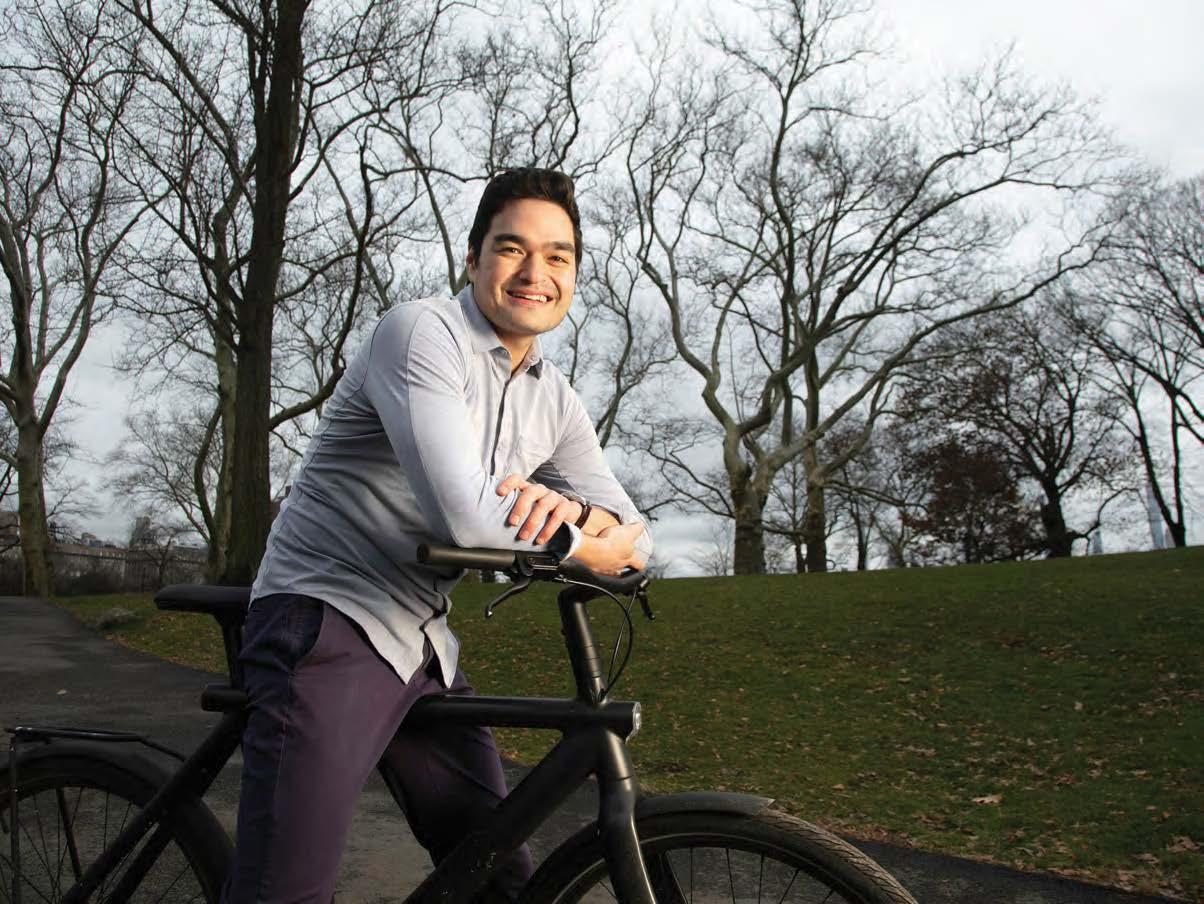
Julianne Cuba, Nick Garber, Jacqueline Neber, Caroline Spivack
CONTACT THE NEWSROOM
editors@crainsnewyork.com
www.crainsnewyork.com/staff
ADVERTISING
www.crainsnewyork.com/advertise
Senior vice president of sales Susan Jacobs (312) 649-5492 or susan.jacobs@crain.com
Director of Sales, Brian Gelsomino
Account executives
David Bowling, Miriam Dreese
People on the move manager Debora Stein
Classi ed sales Suzanne Janik, (313) 446-0455 or sjanik@crain.com
Sales assistant Josephine Call
Inside sales Isabel Foster
CRAIN’S CONTENT STUDIO
www.crainsnewyork.com/custom
Senior director of Crain’s Content Studio Kristin Bull, (313) 446-1608 or kbull@crain.com
Crain’s Content Studio associate director Sophia Juarez
EVENTS
www.crainsnewyork.com/events
Senior manager of events Michelle Cast Manager of conferences & events Ana Jimenez
PRODUCTION
In the summer of 2022, Adrian Silver decided to take a chance.
In anticipation of that September’s Climate Week, New York’s annual bonanza of climate action events, Silver created an Eventbrite page inviting queer climate professionals to a low-key outdoor gathering.
“I said, ‘If you identify as queer and you want to meet up, come to Central Park,’ so literally the lowest lift,” said Silver. After searching around online, he was amazed that there wasn’t a group actively working to create community for LGBTQ+ professionals in the city’s climate space.
e casual Central Park meetup was a hit. About 30 people showed up, including a few sustainability and climate-tech enthusiasts who happened to be working to create a similar group as Silver. ey merged their e orts into one nonpro t now known as Out in Climate.
For Silver, co-founding the organization was a way for him to give back after bene ting from a similar group on the West Coast. Upon graduating from Columbia University in 2015, Silver moved to San Francisco to work at Carbon
Lighthouse, a prop-tech startup focused on decarbonization within commercial real estate. While living in California, Silver discovered the Lesbian and Gay Real Estate Group, a networking organization for commercial real estate professionals, which helped him better understand the industry, and the emerging role of sustainability within it, in a welcoming environment.
“It ended up being a refuge, like an absolute lifesaver for me to feel like there was a trajectory in this industry for me,” said Silver. “To have this networking group where I could see people senior in the industry who were willing to mentor me and have all these events, it was just this incredibly safe space where I felt much more at ease and much more comfortable in myself.”
A career in climate was never in doubt for Silver, who said he was driven to learn more about cities and sustainability in college. e more he learned, building decarbonization increasingly seemed like the right t.
By | Caroline SpivackAdrian Silver created an Eventbrite page in the summer of 2022 for a low-key outdoor gathering that became a nonpro t
Silver returned to the city a few years later, in 2017, to help Carbon Lighthouse launch its New York ofce. After he came back, it just made sense to him to tap into what he describes as his “superpower” — relationship building — to eventually form a similar space to the Lesbian and Gay Real Estate Group but for climate instead.
“It was driven by positivity: Wouldn’t it be great if there was a space where I could feel a little more comfortable and we can talk about professional things in climate but also let our hair down a little bit?” said Silver. “And just selfishly, I wanted to meet more people who are queer in climate. Part of it was, who else is out there?”
In his current role of carbon strategist at Carbon Direct, a Financial District-based startup where he started in 2022, Silver spends his time delving into the brass tacks of decarbonization with nancial service companies, private equity rms, philanthropic foundations and others. “It's really ful lling to know that every day I'm working on something that matters,” said Silver.
Roughly a year and a half since Out in Climate’s founding, Silver
Born Boston Resides Harlem
Education Bachelor’s in urban studies, Columbia University
Classically trained Silver is a talented pianist who learned to play as a child; he has performed at Carnegie Hall.
Sportsman Since 2017, Silver has organized a basketball league that meets up every Sunday for games in the East Village. “It’s sort of like my church,” he said.
says the experience has only deepened his passion for bringing people together, work he hopes eventually will grow to include mentorship opportunities and helping people advance in their career.
“Some companies are too small or just don't have employee resource groups,” said Silver, “so having an external group where it’s, ‘I can meet other people like me,' is in and of itself a win.”
Vice president, product Kevin Skaggs
Product manager Tim Simpson
Production and pre-press director Simone Pryce
Media services manager Nicole Spell
CUSTOMER SERVICE
customerservice@crainsnewyork.com or (877) 824-9379
Director, reprints & licensing Lauren Melesio, (212) 210-0707 or lmelesio@crain.com
